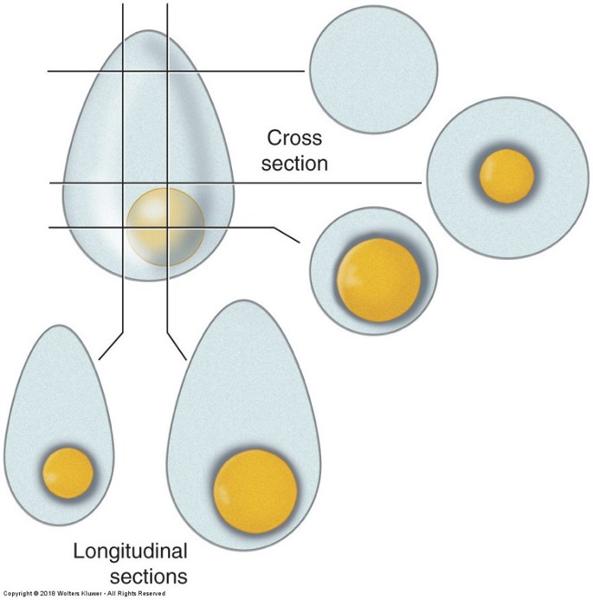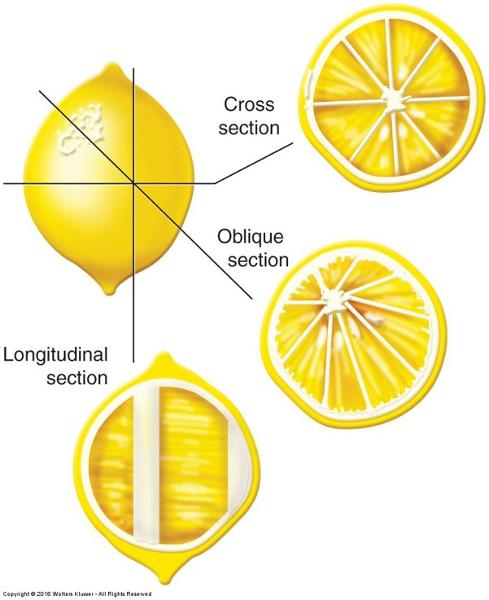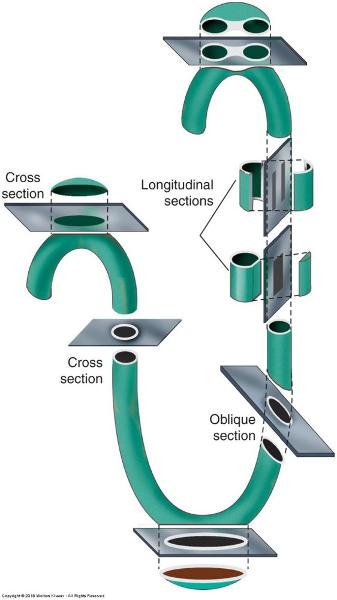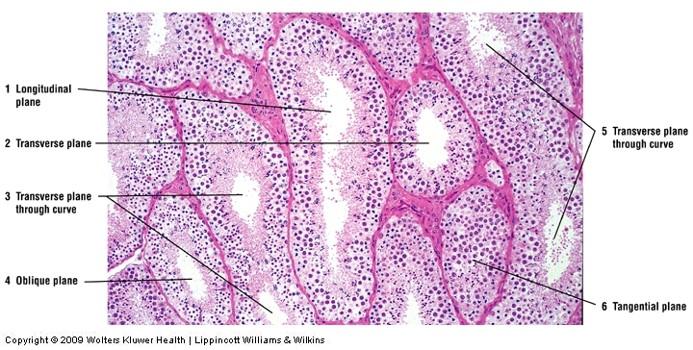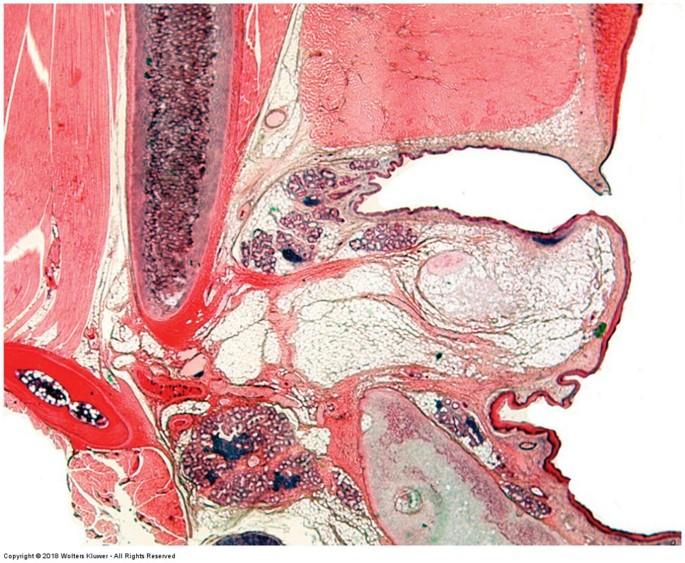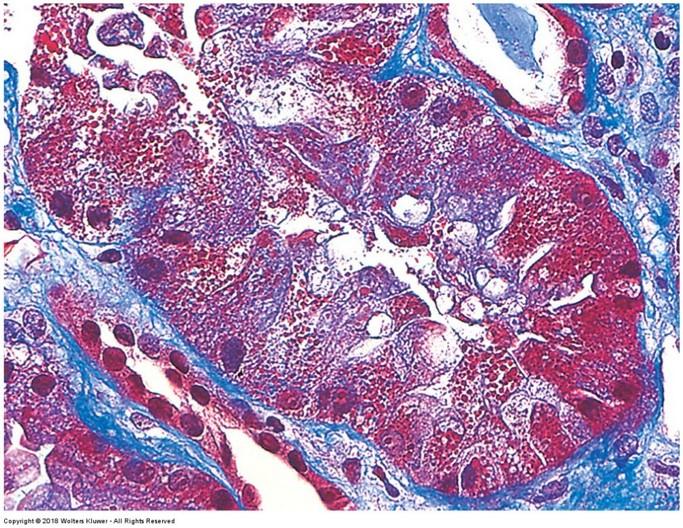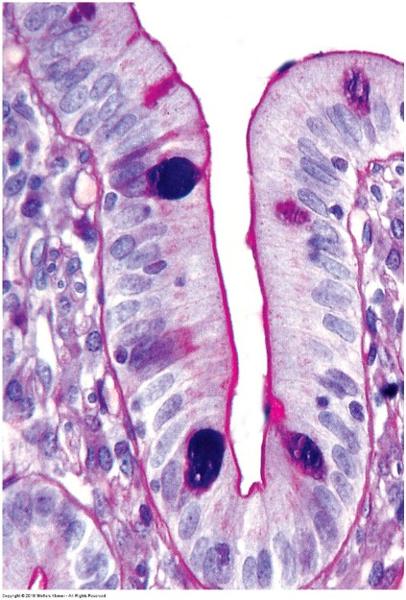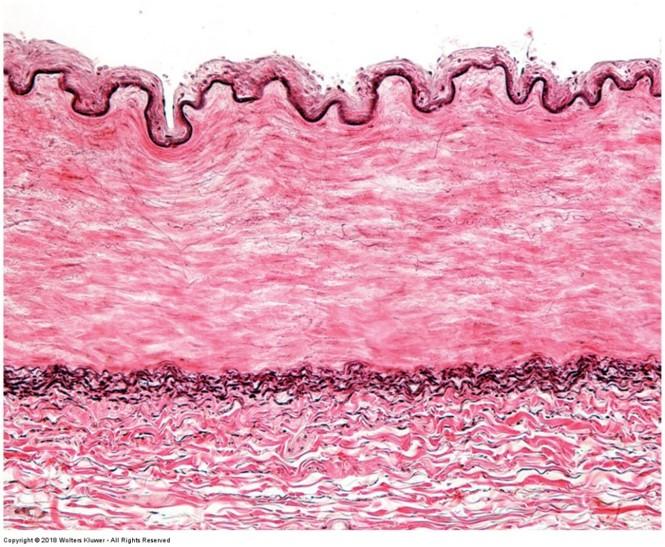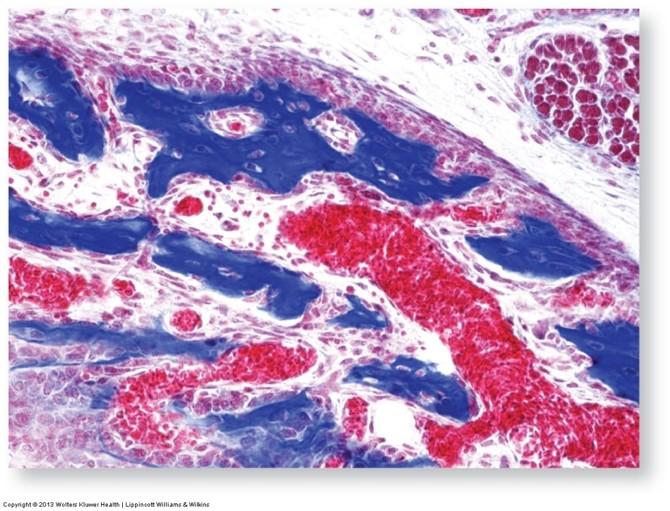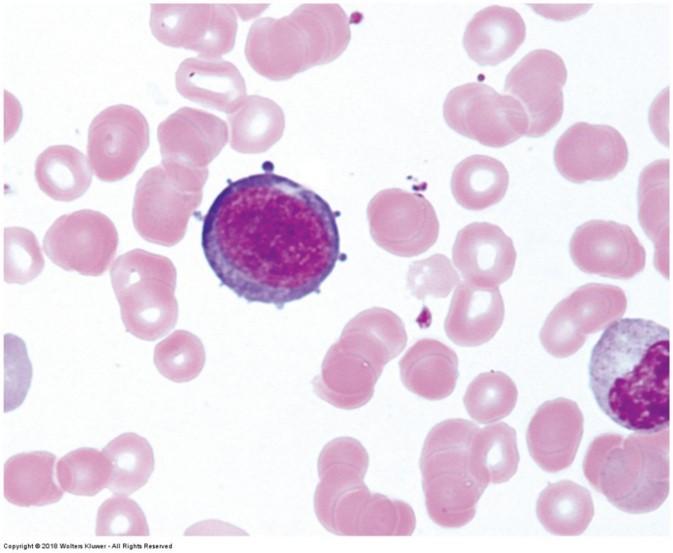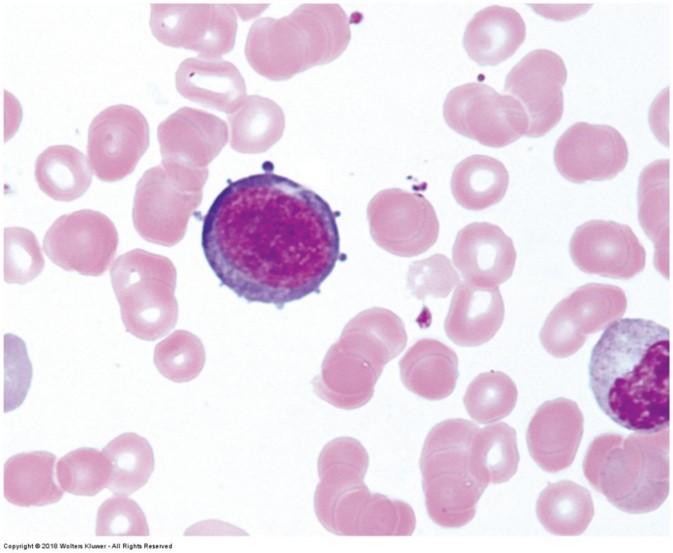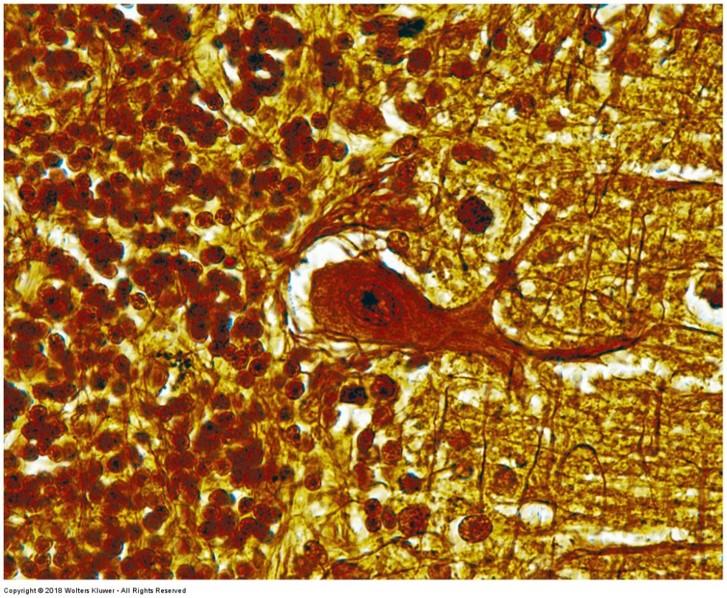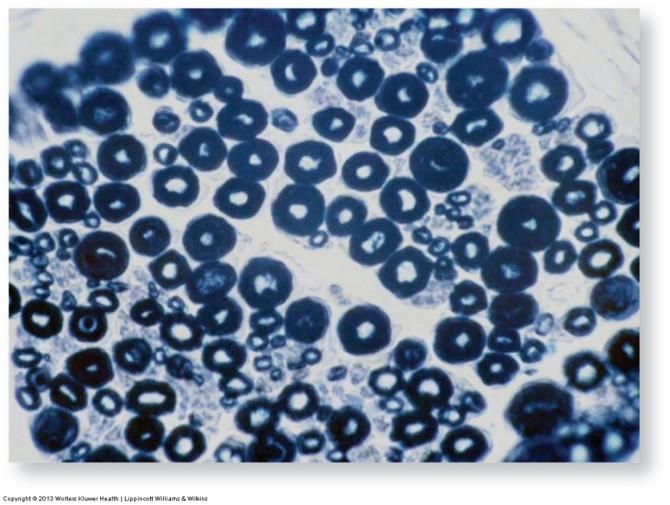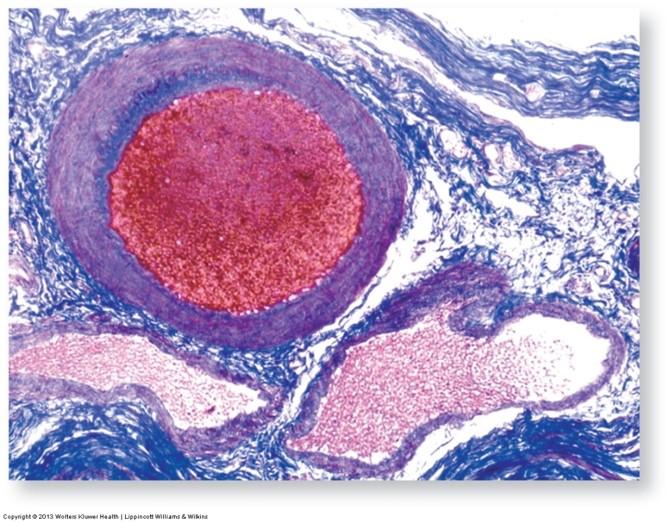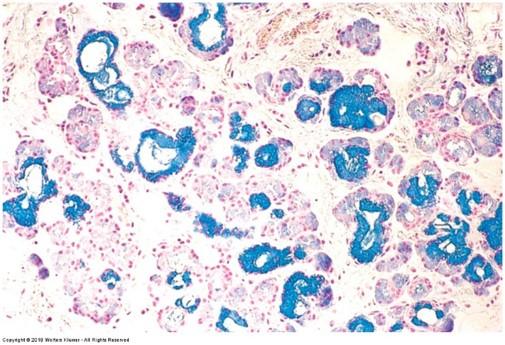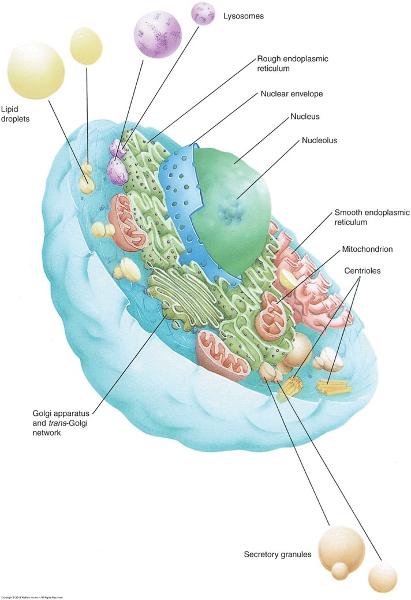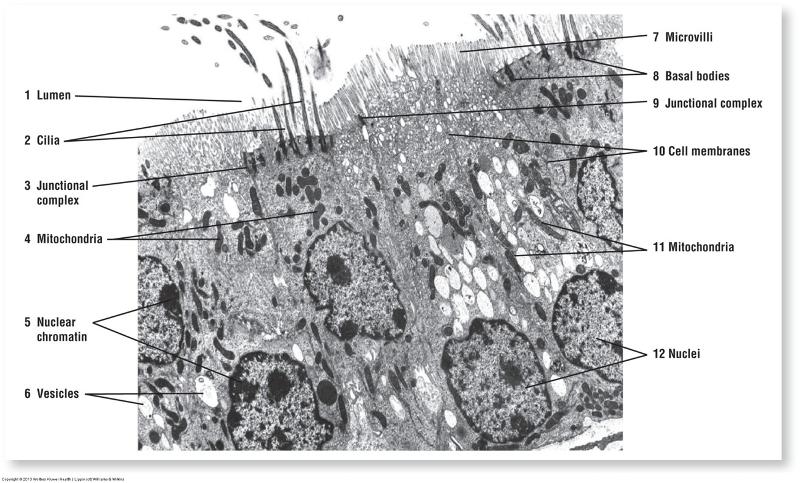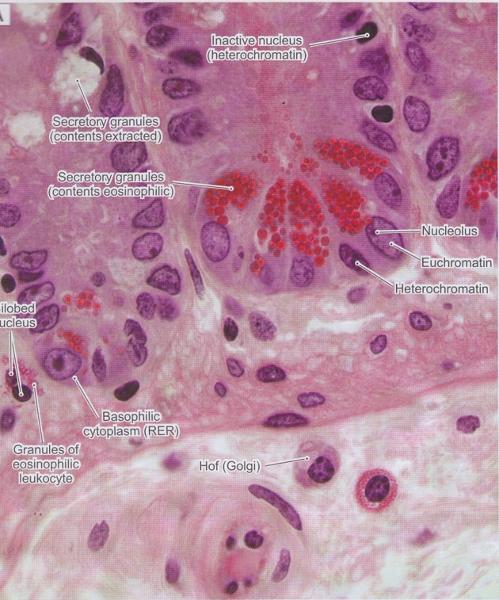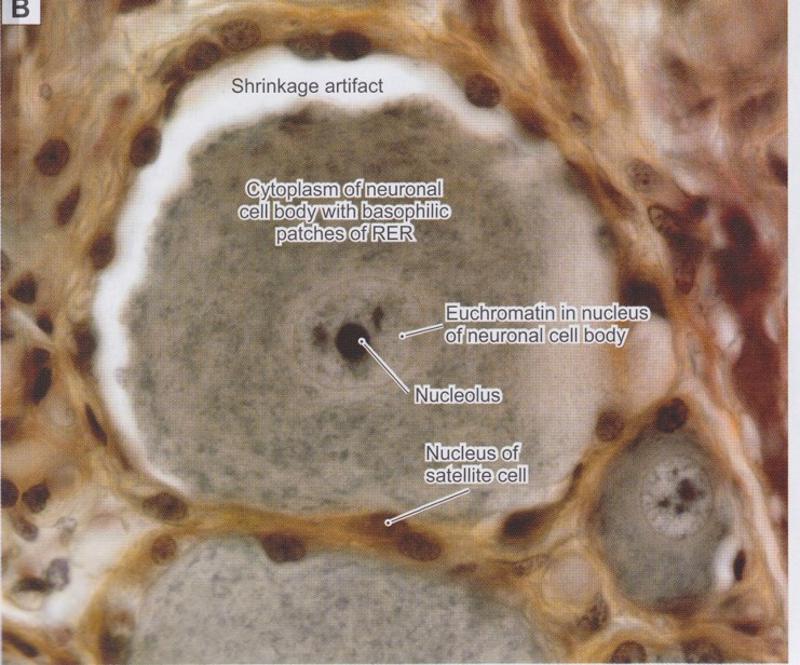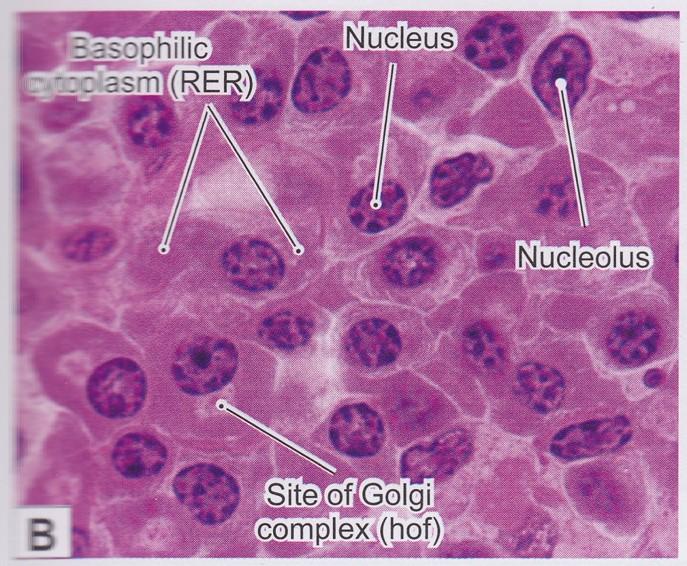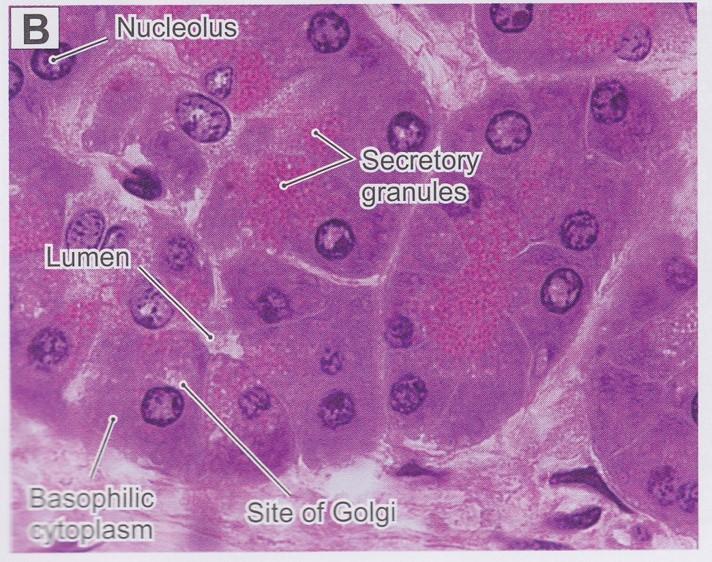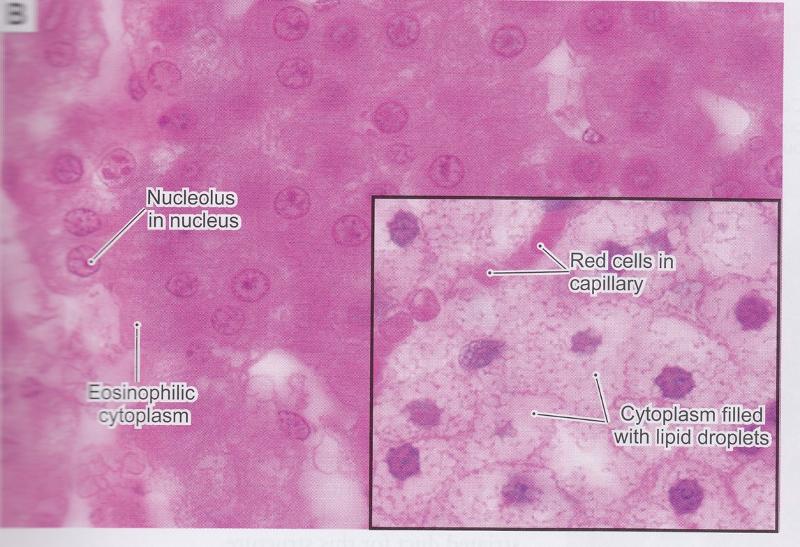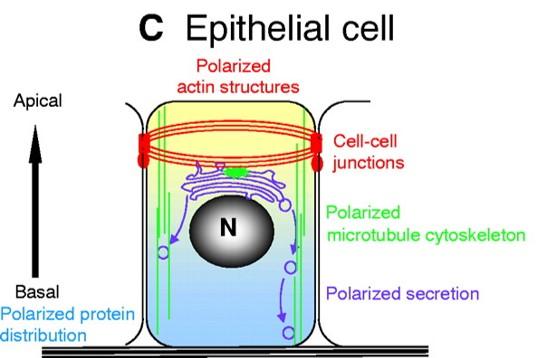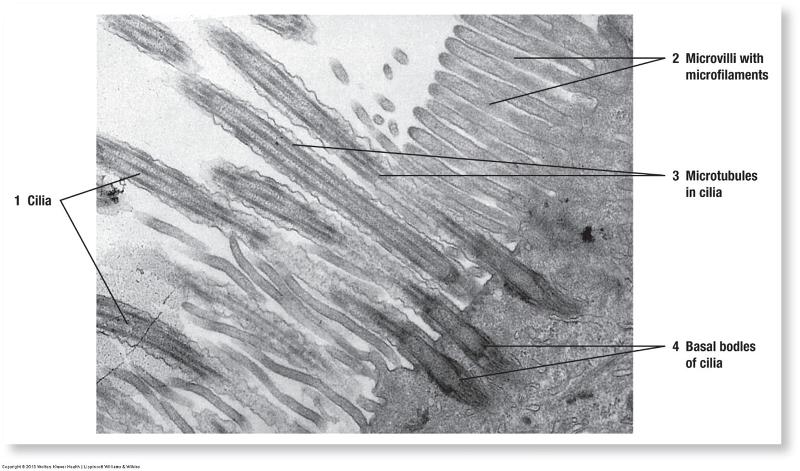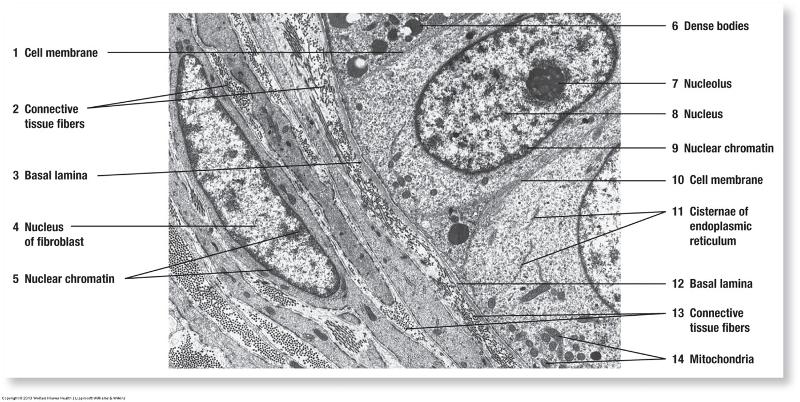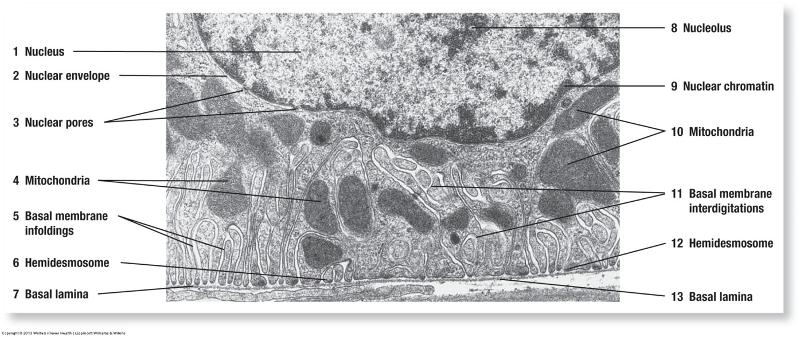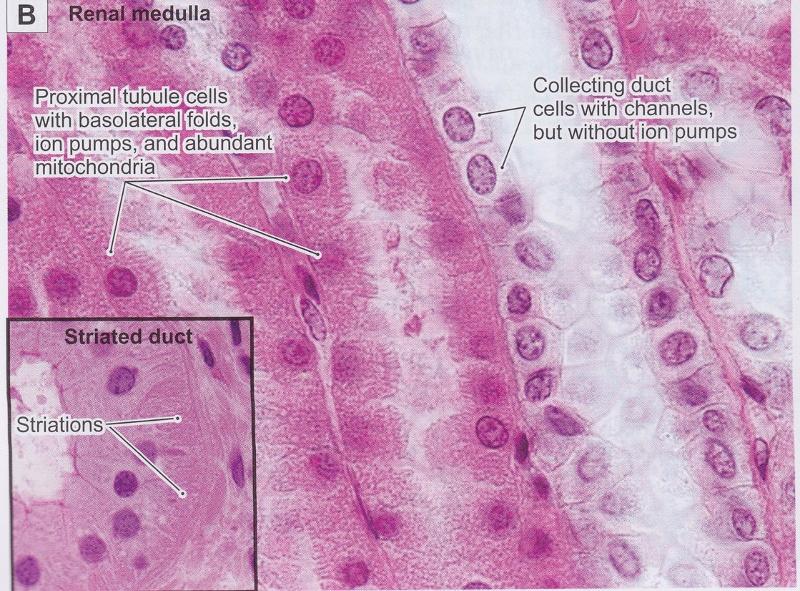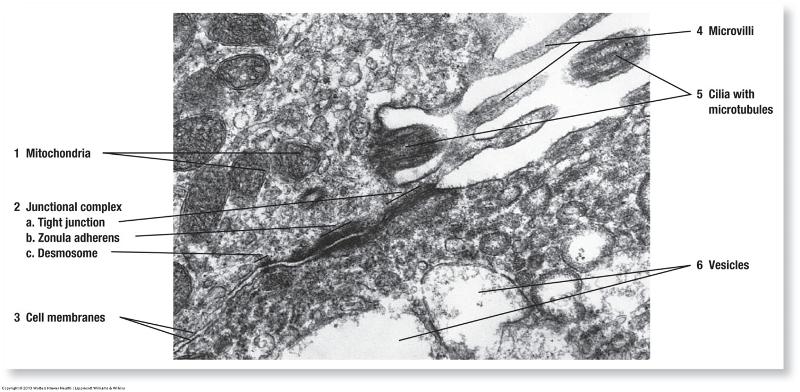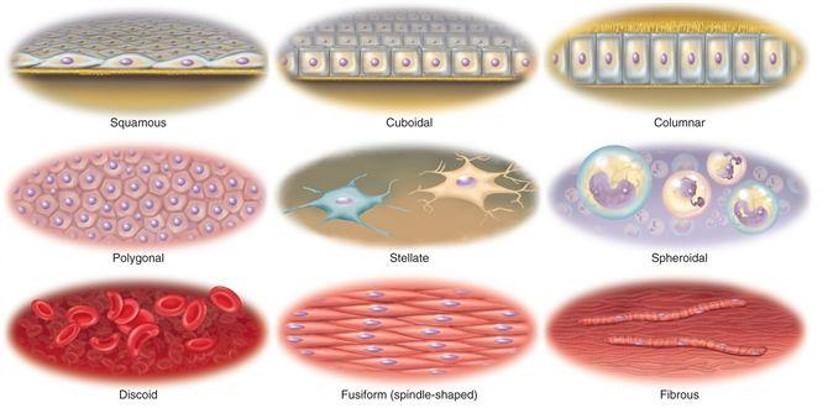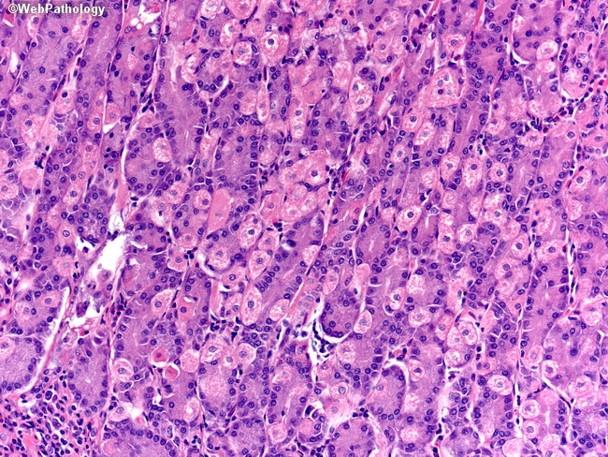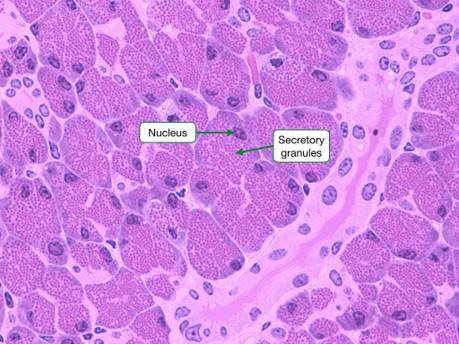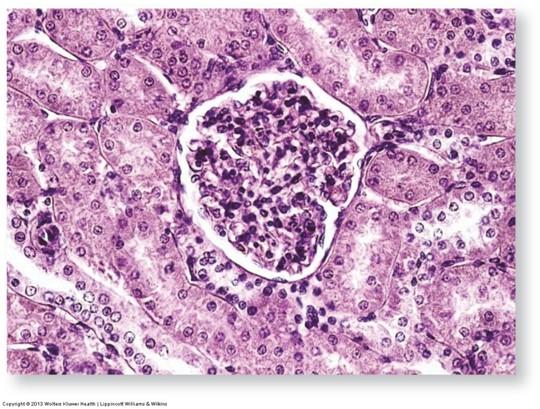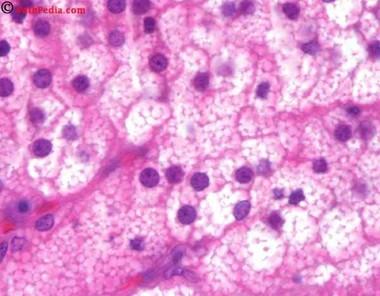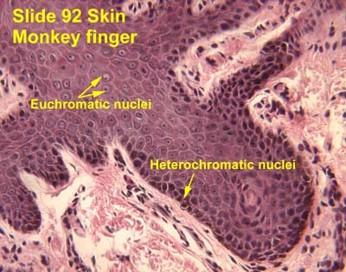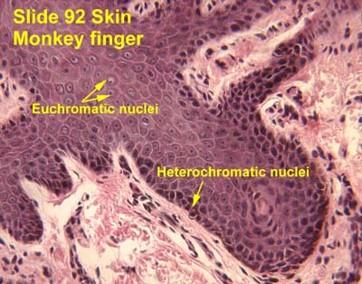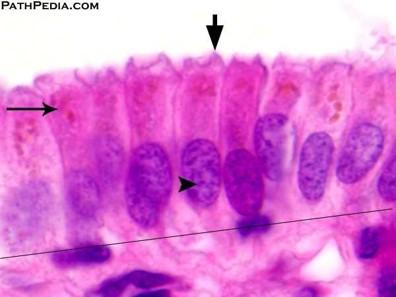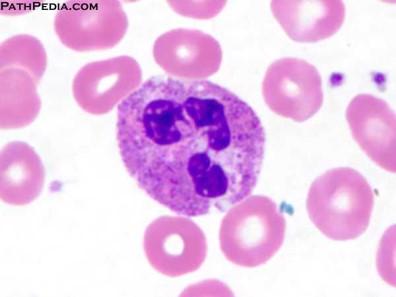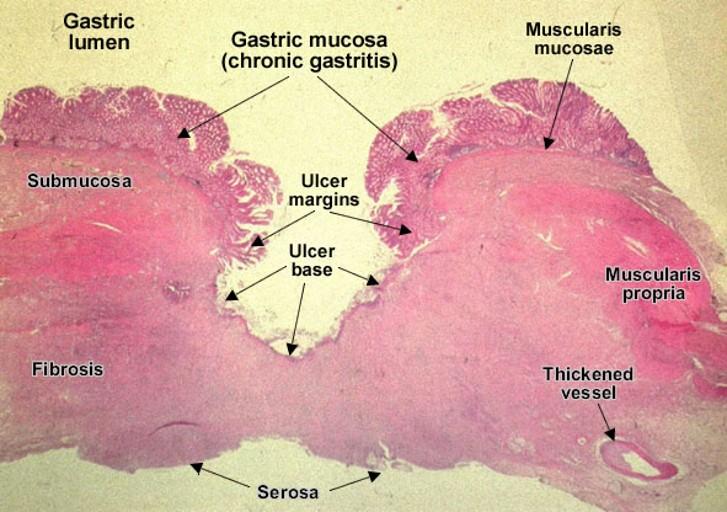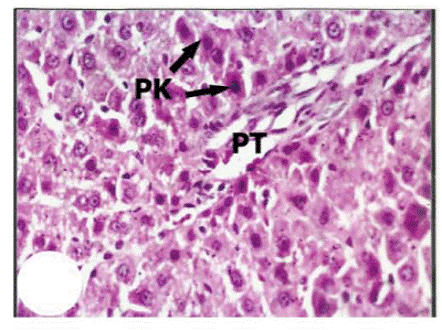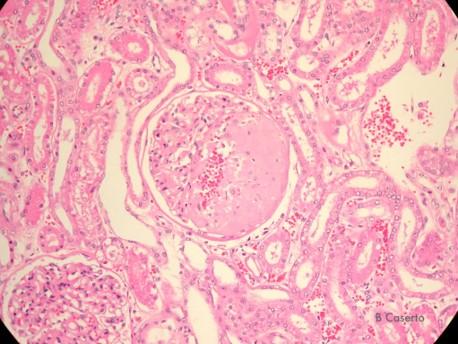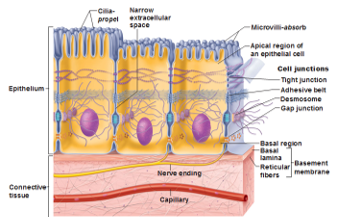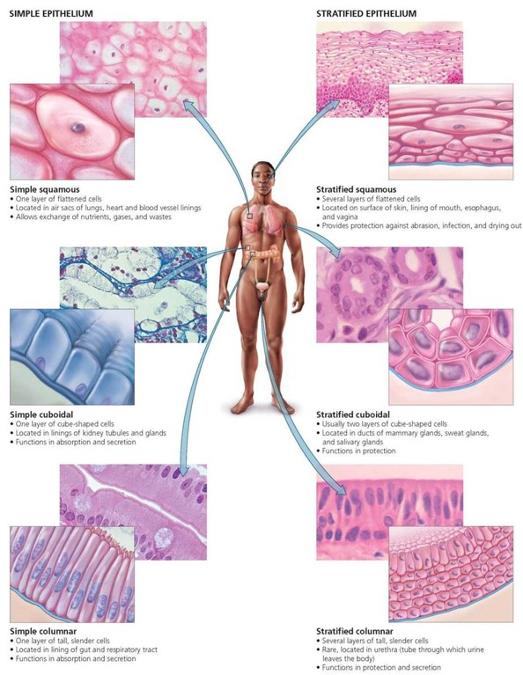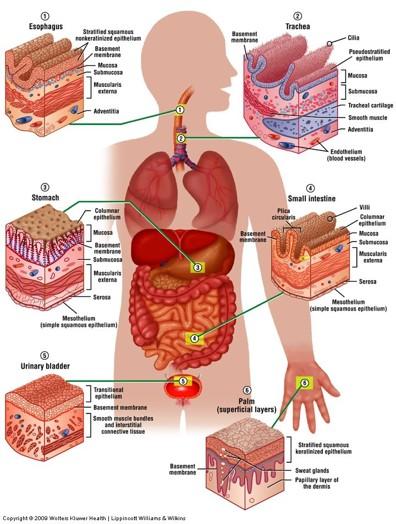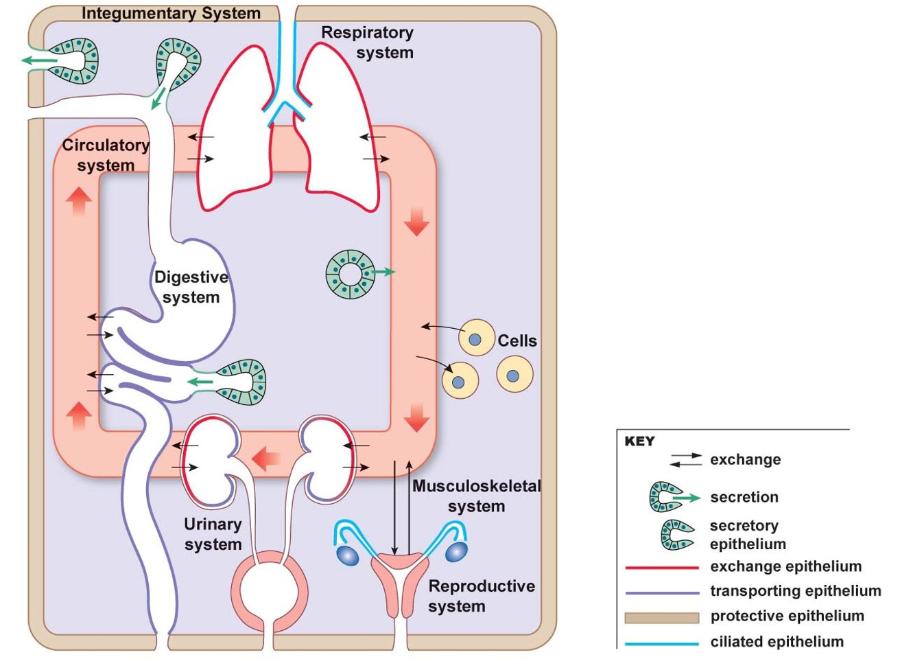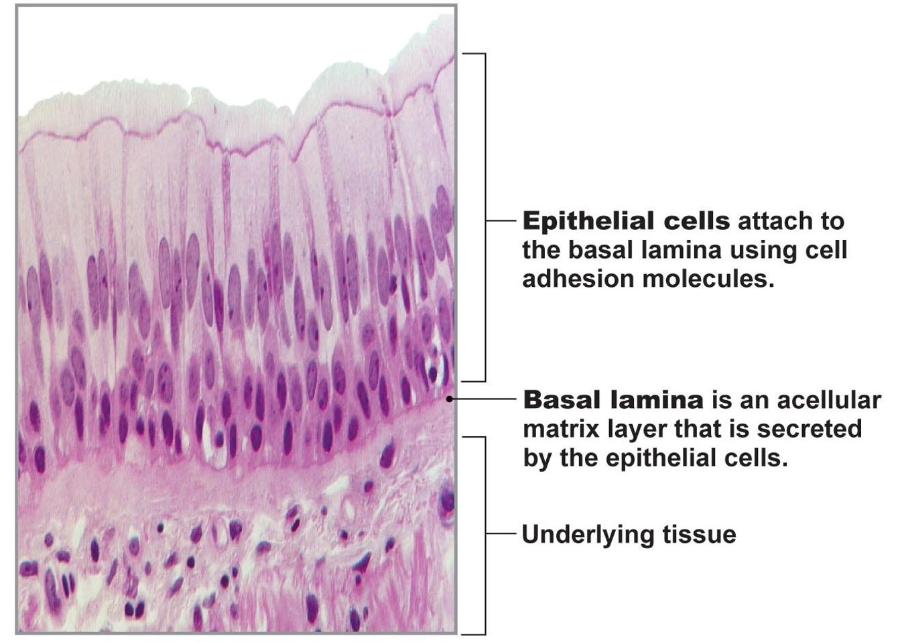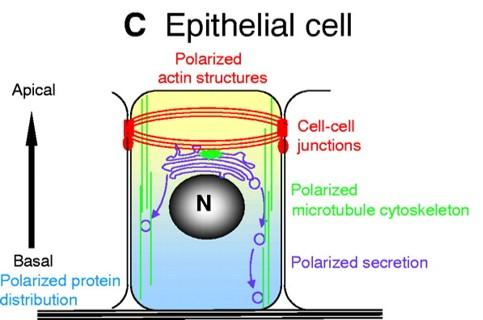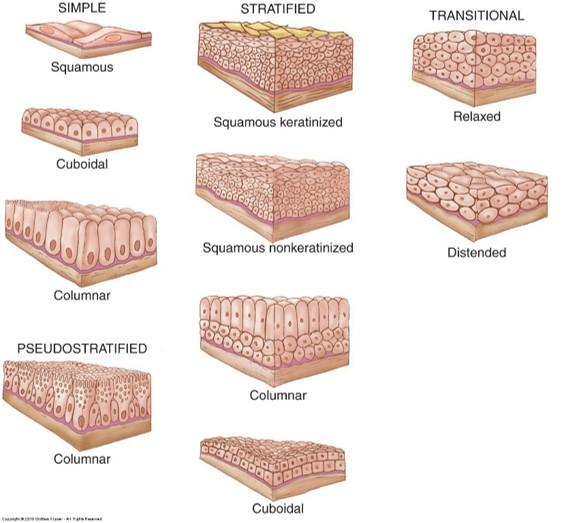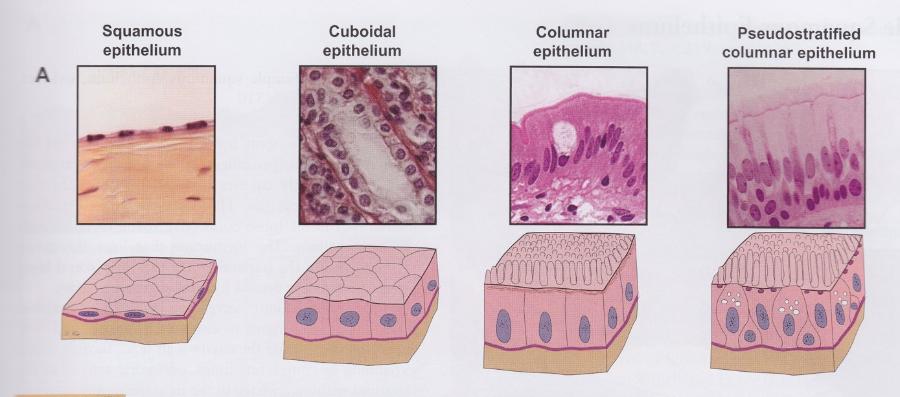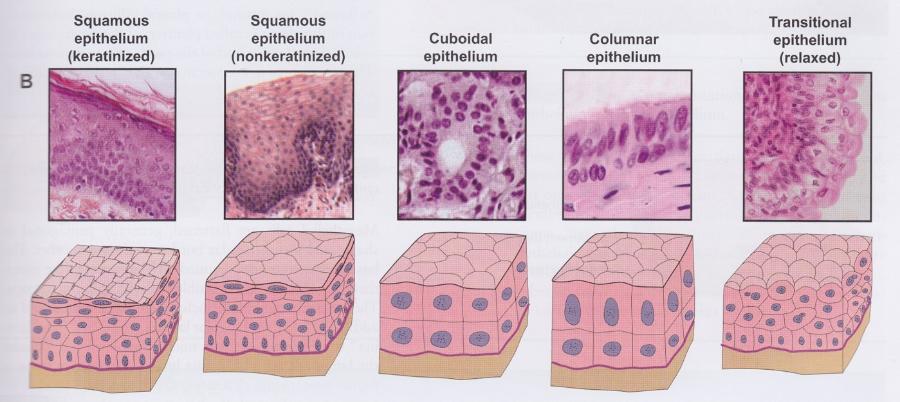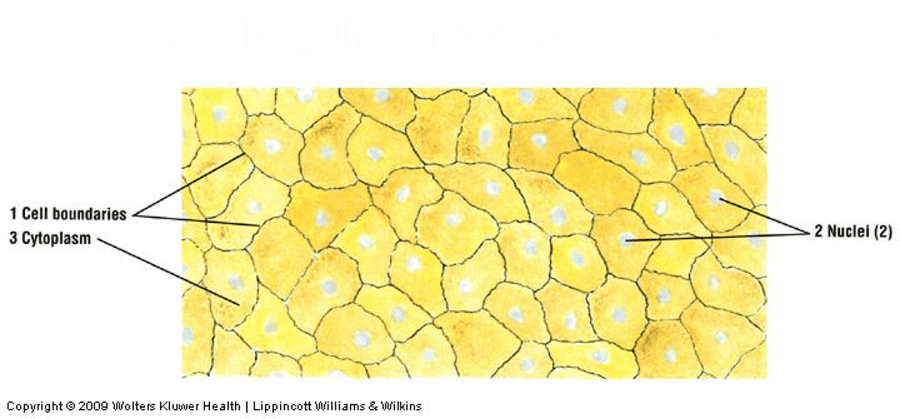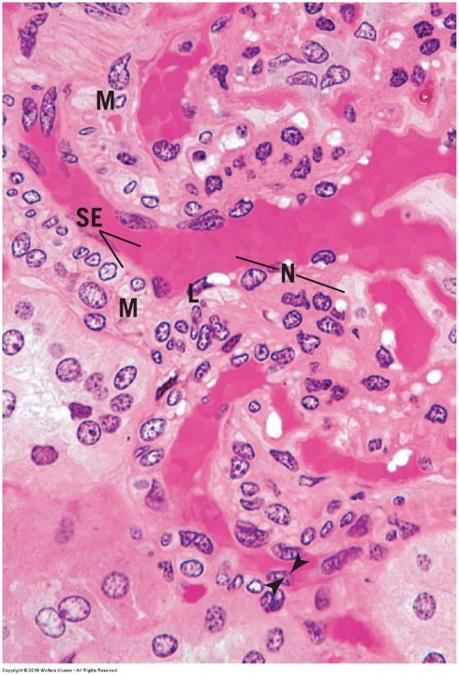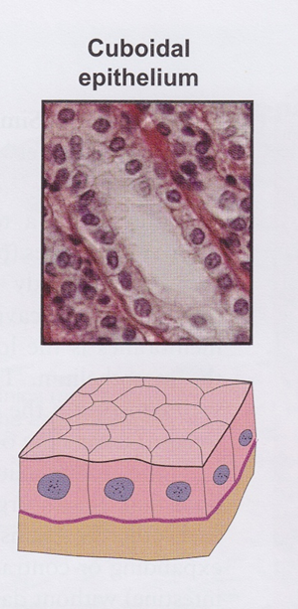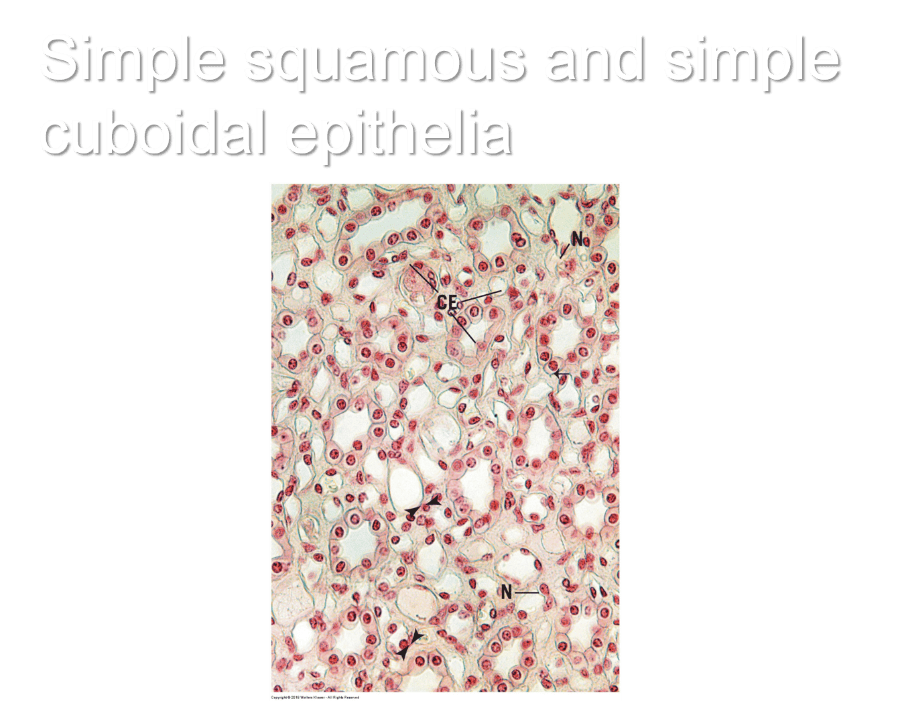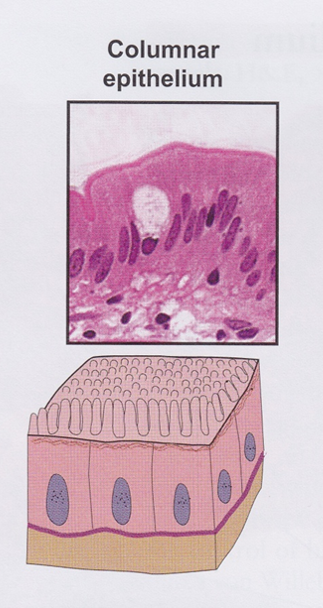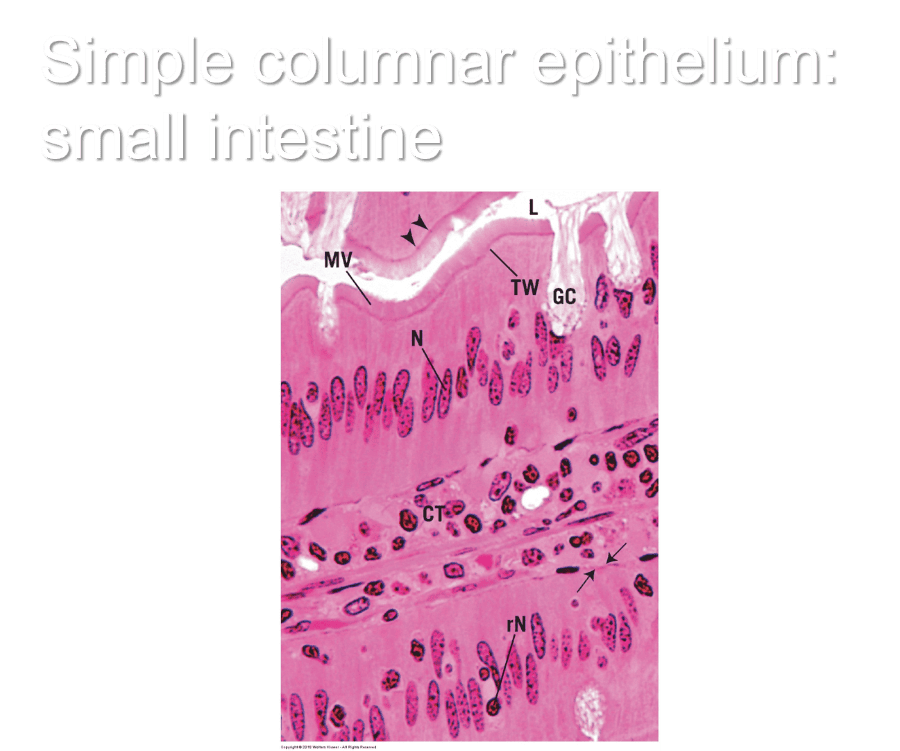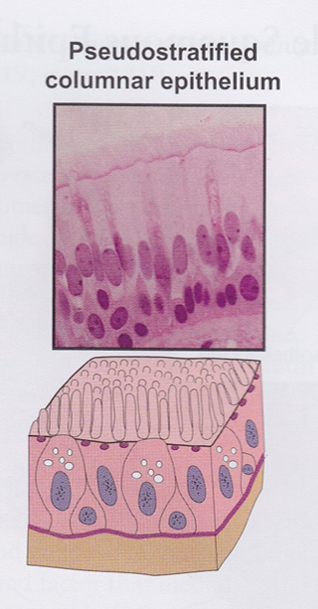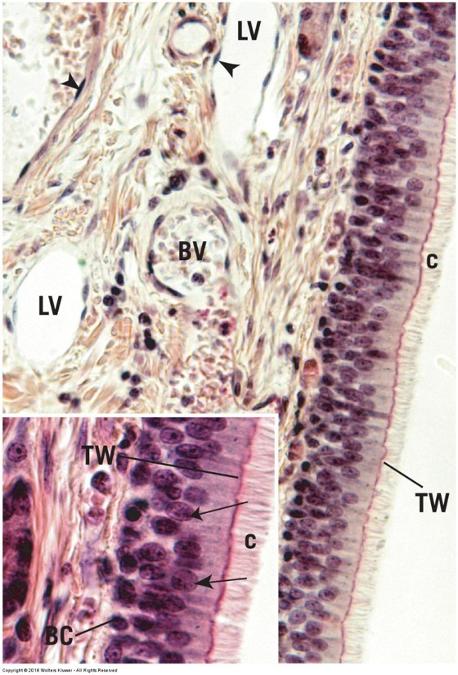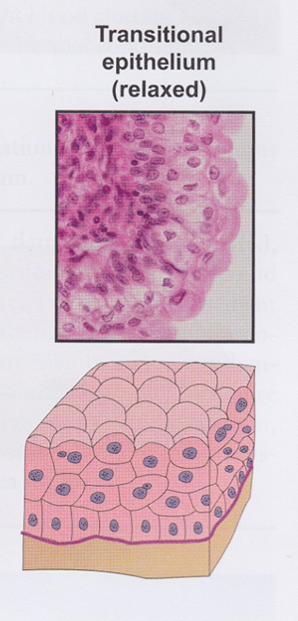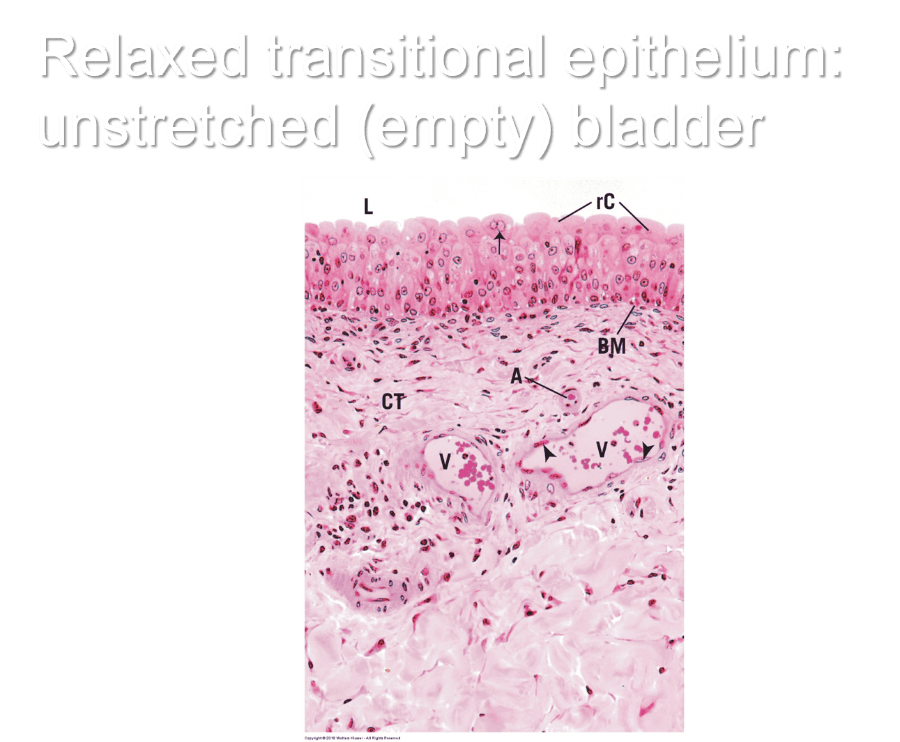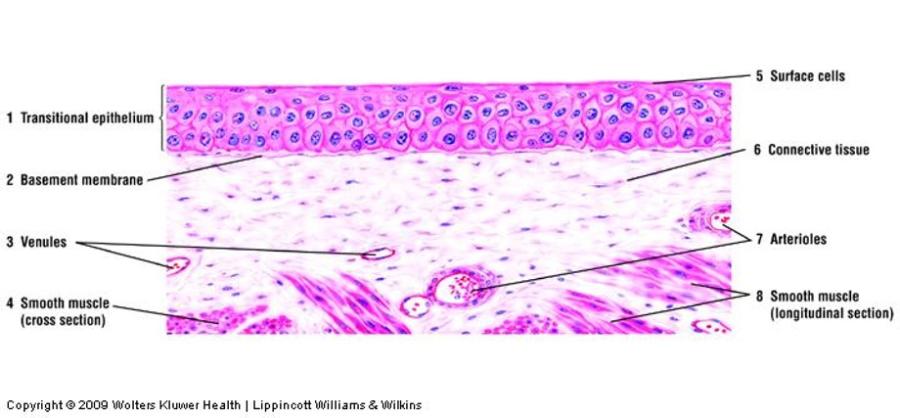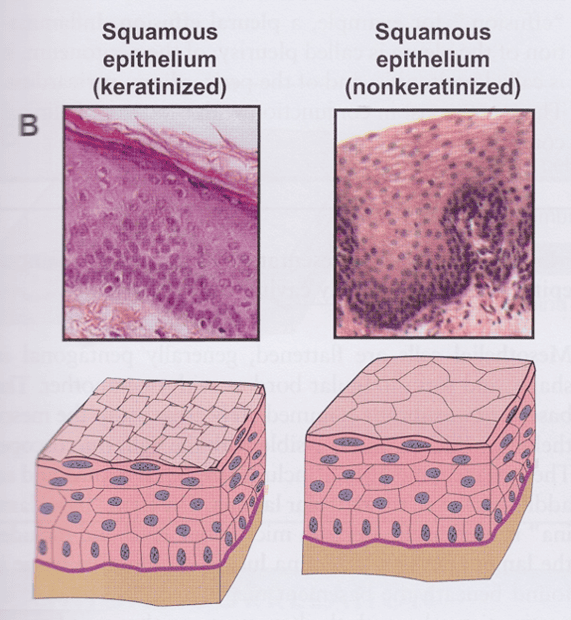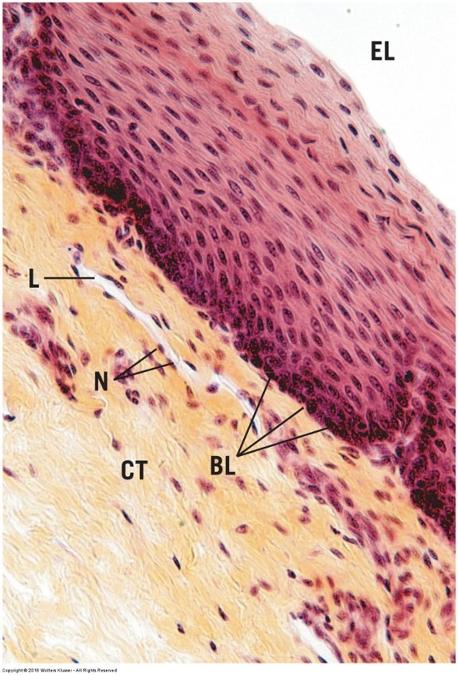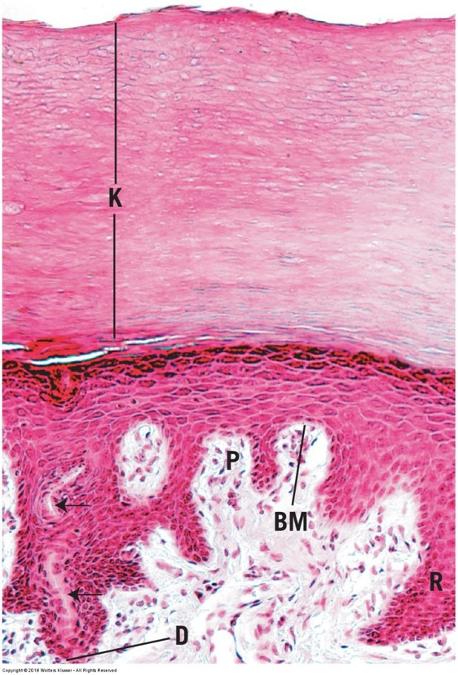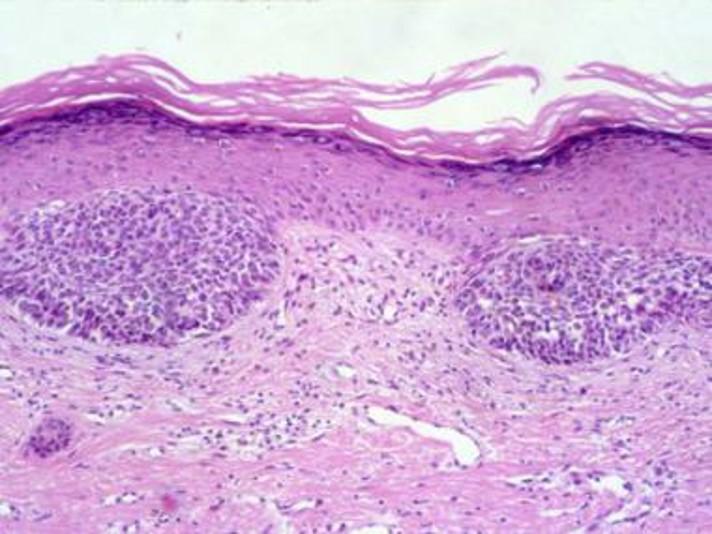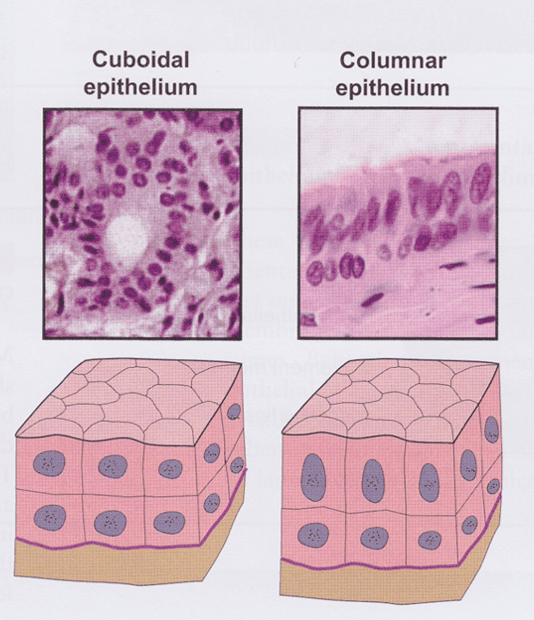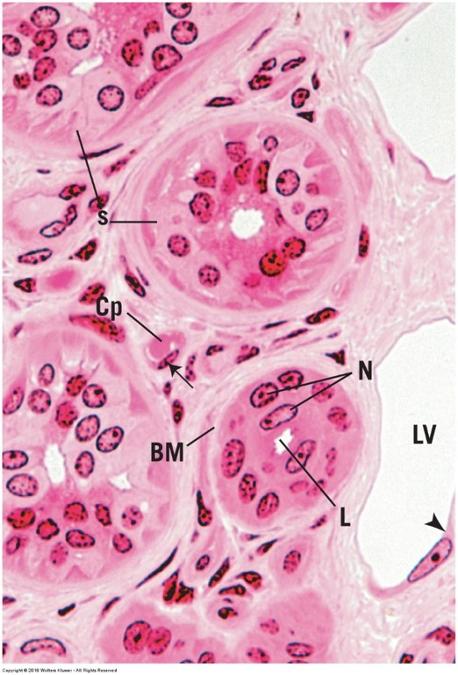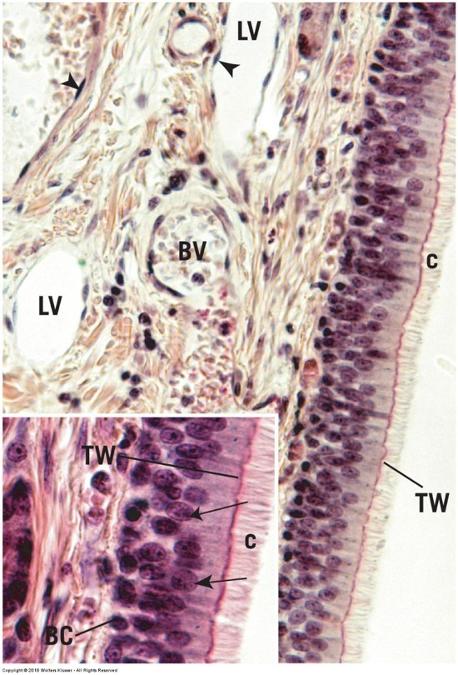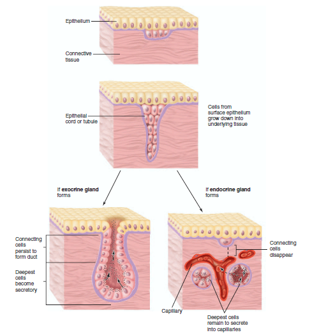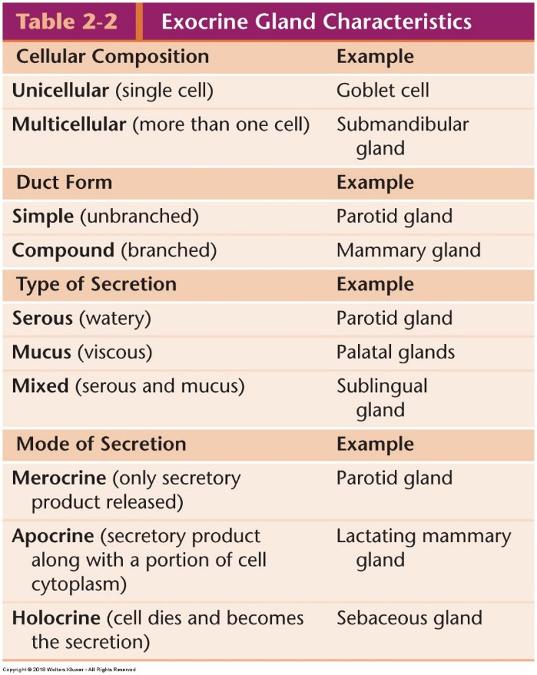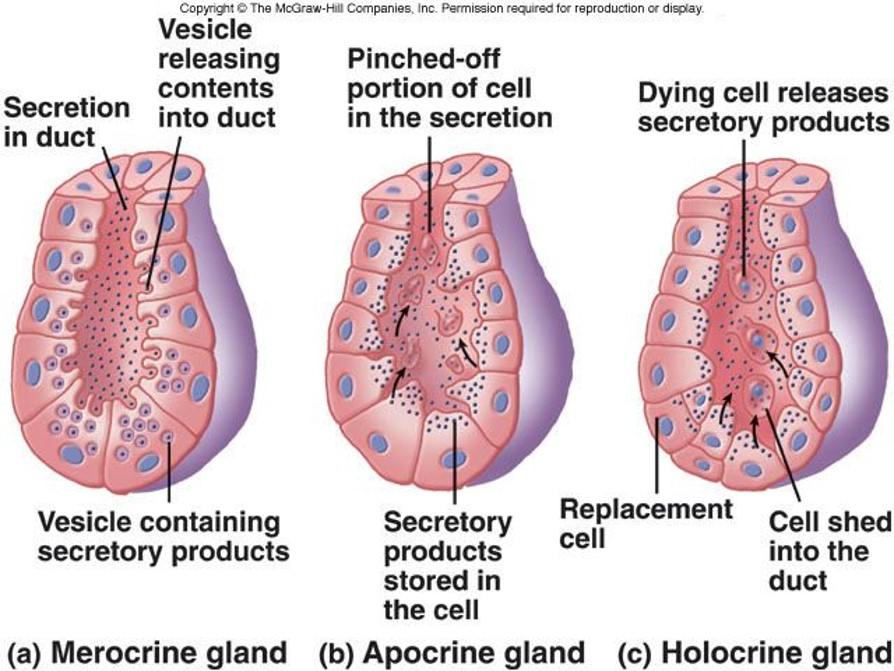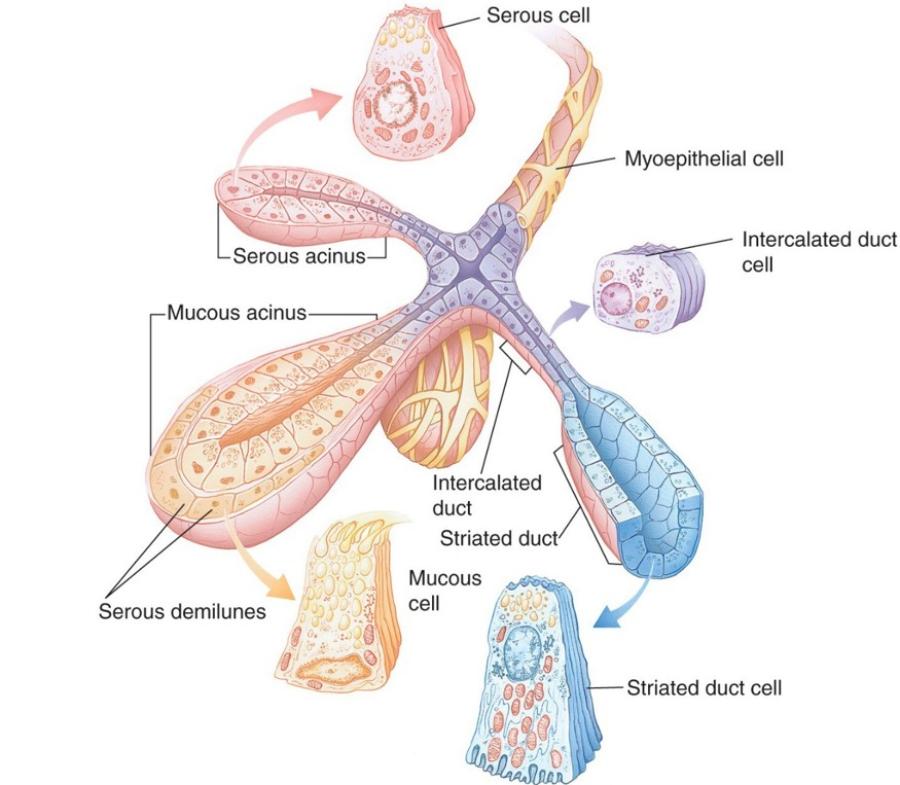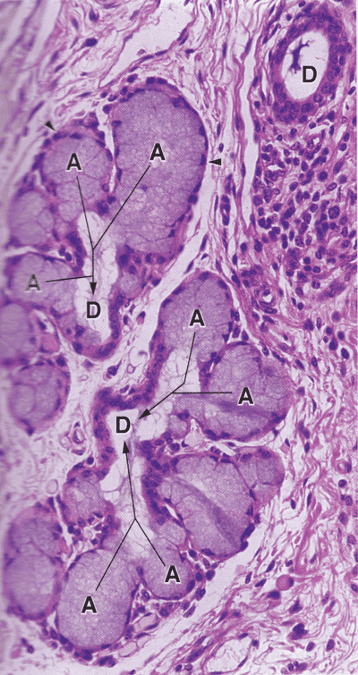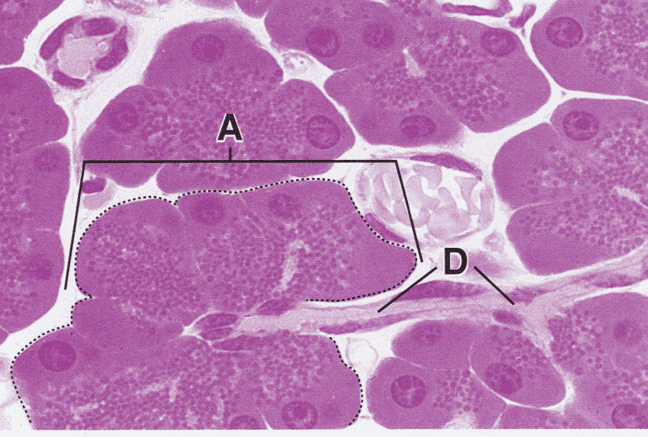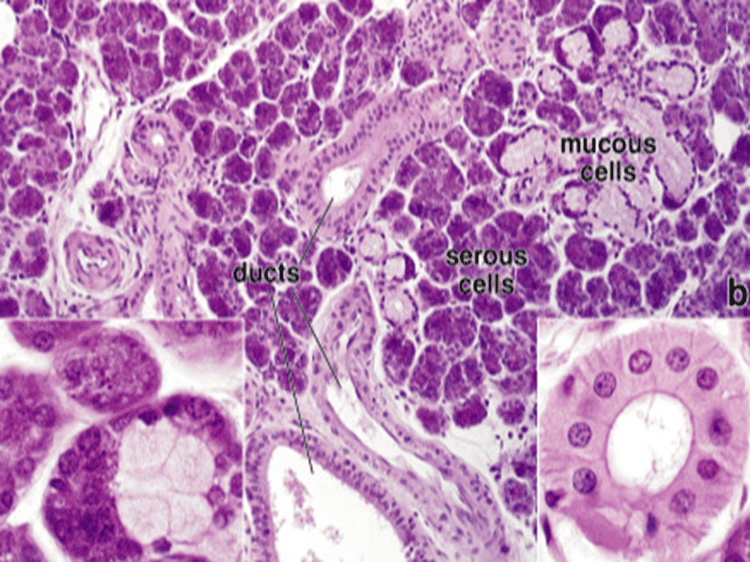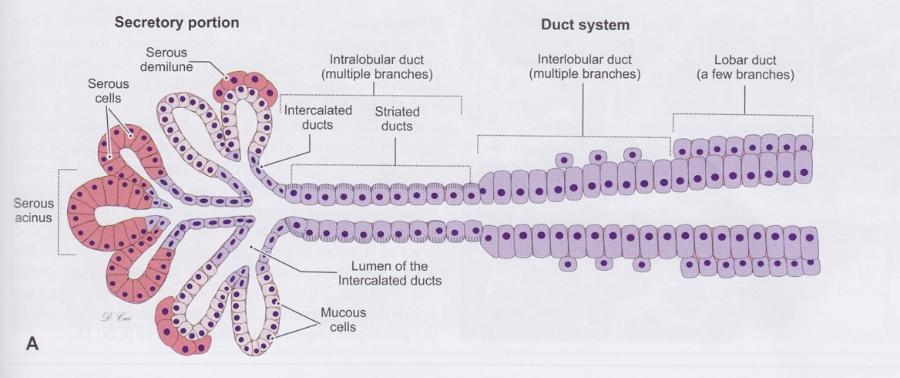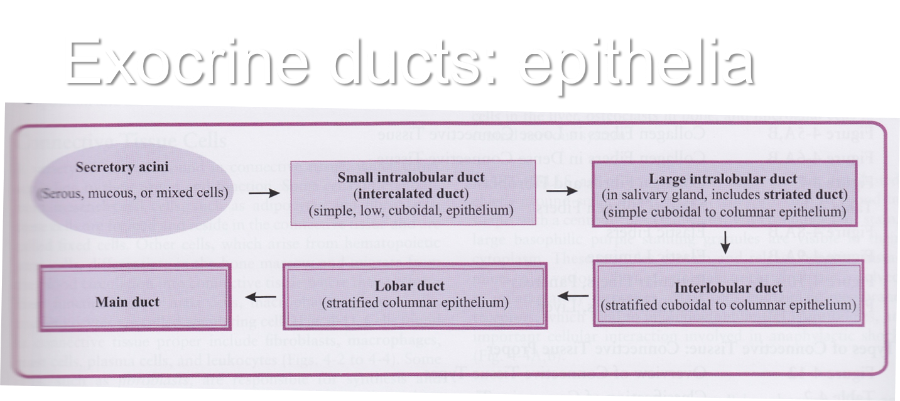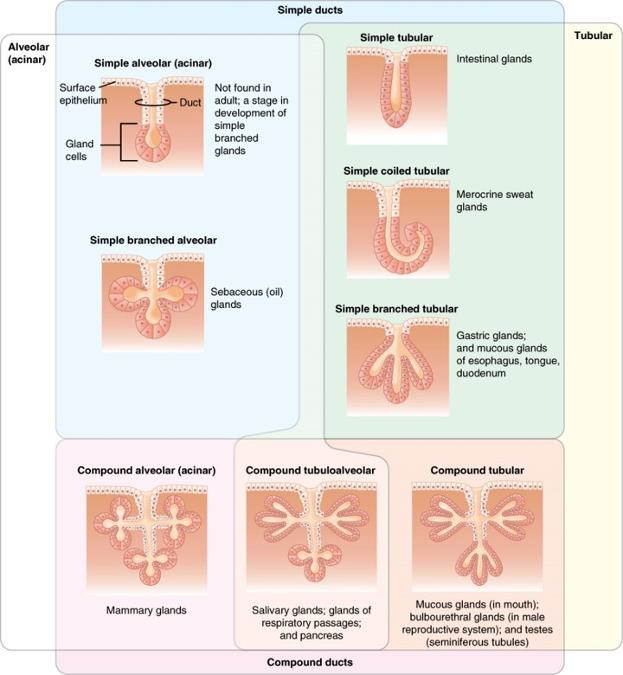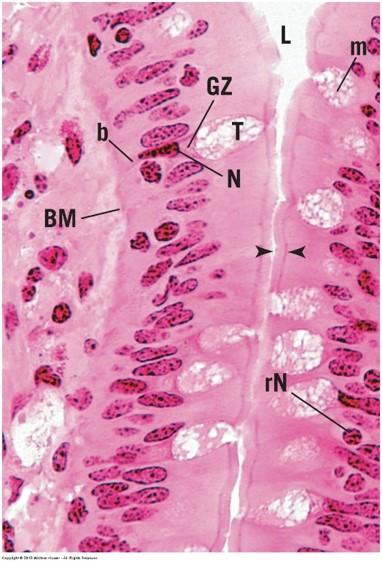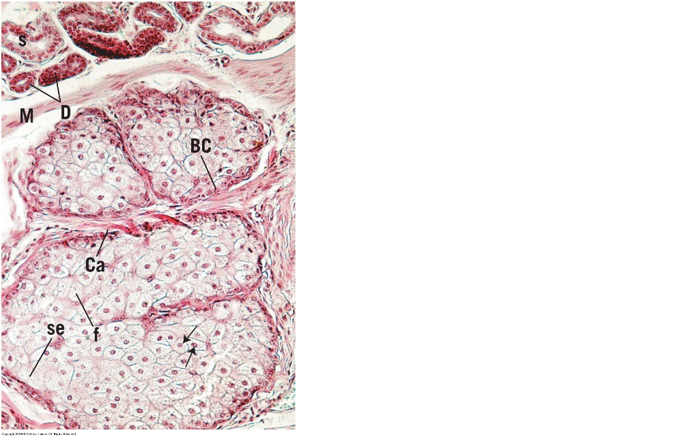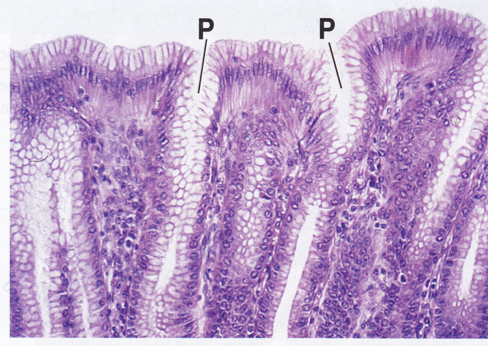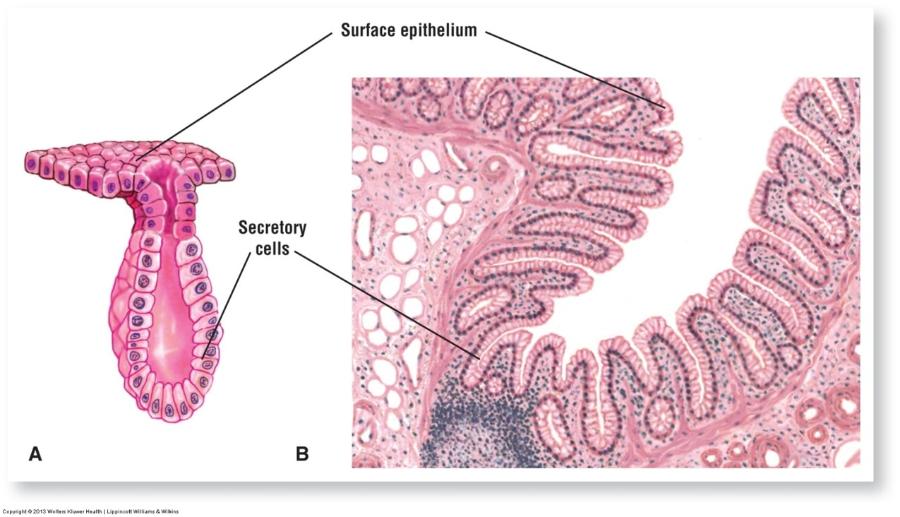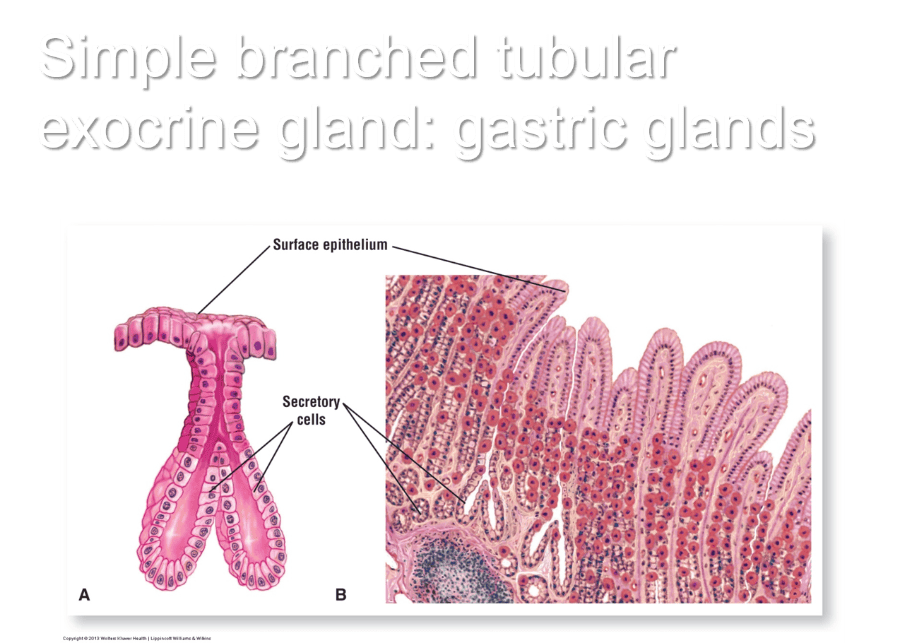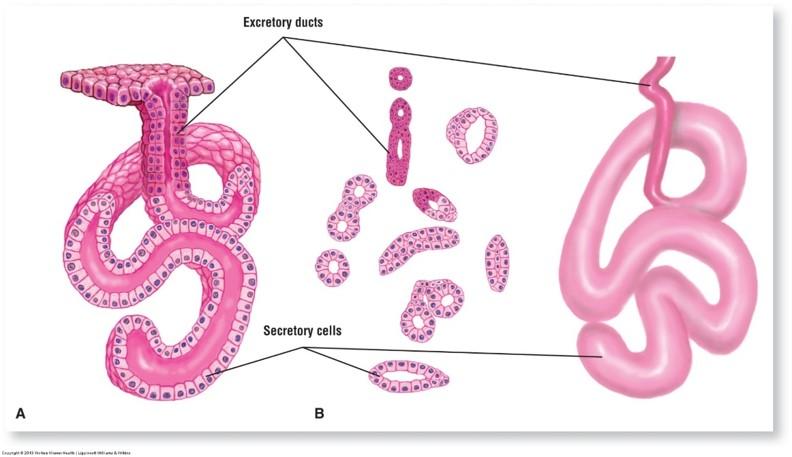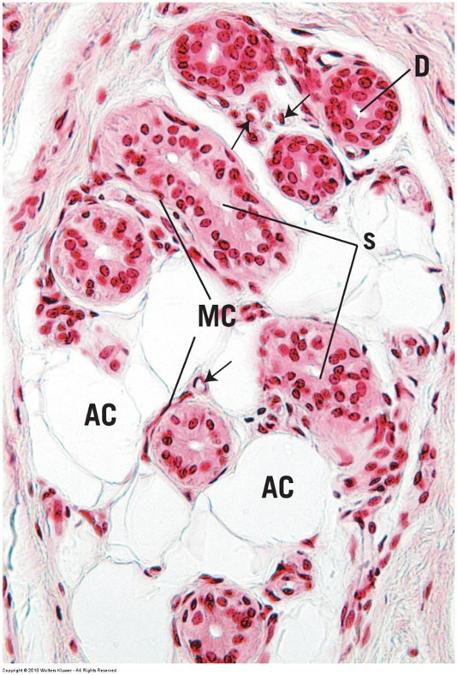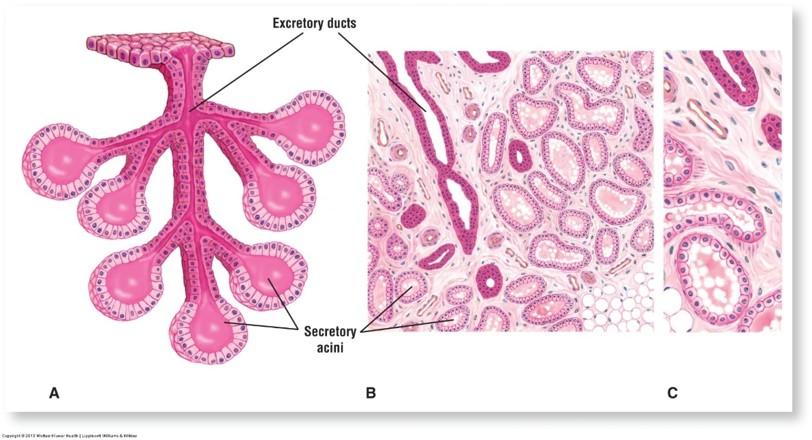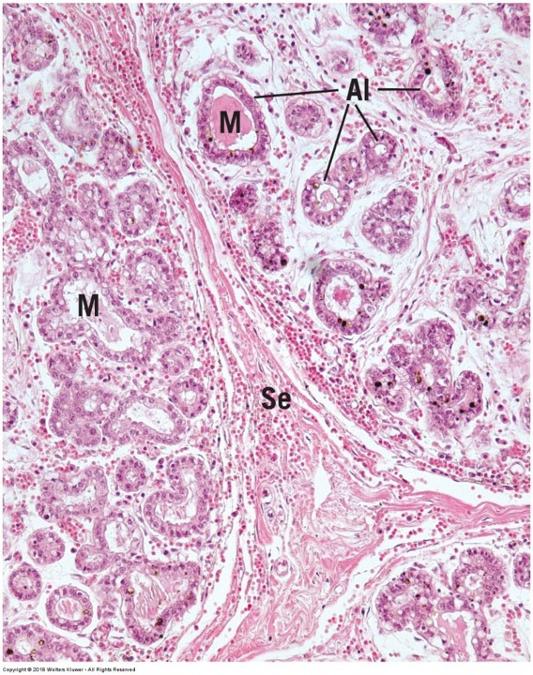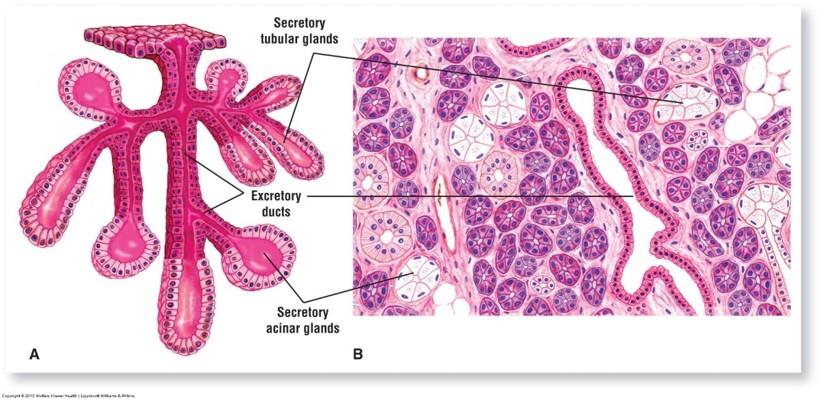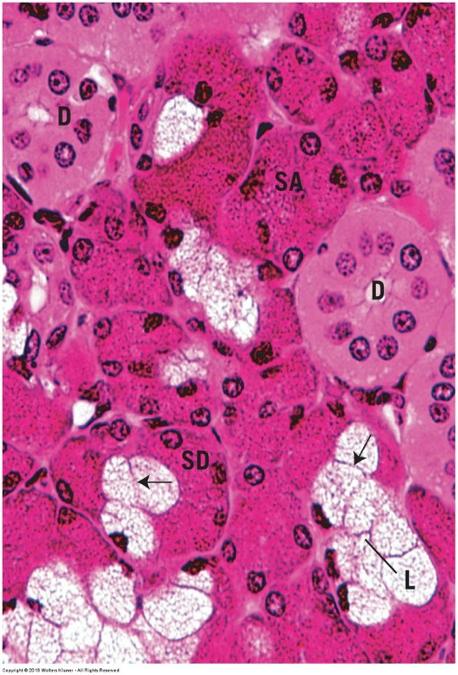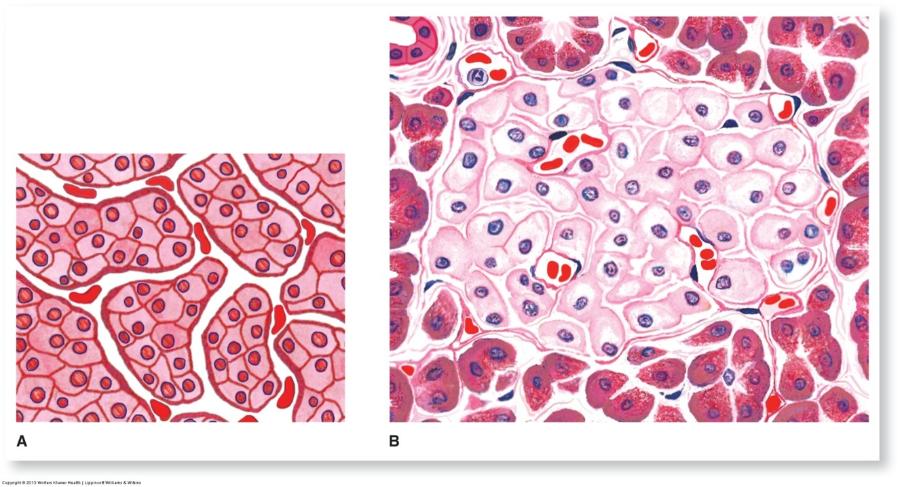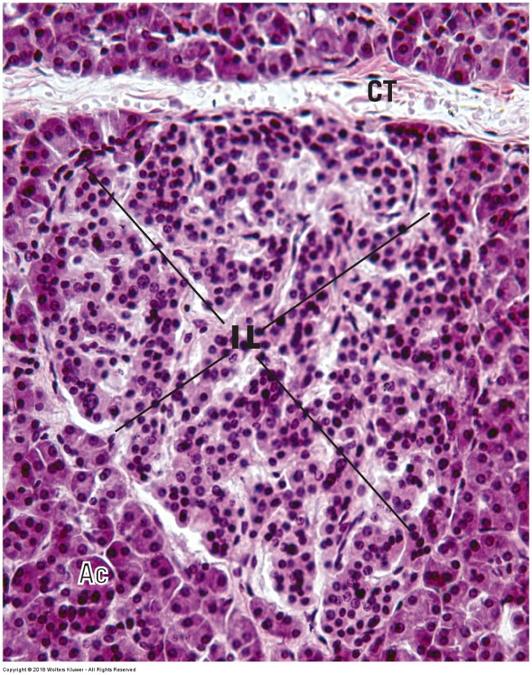| back 1 Purpose of course in histology is to understand the microanatomy of cells,
tissues, and organs and to correlate structure with function. |
| back 2 - Thin, flat slices of fixed and stained tissues or organs
mounted on glass slides
- Tissues and organs composed of
cellular, fibrous, and tubular structures
-
Cells: variety of
shapes and sizes, may be layered
-
Fibrous: solid
structures found in connective, nervous, and muscle tissues;
“fibers”
-
Tubular: hollow,
represent blood vessels, ducts, or glands
|
| back 3
Transverse/cross section
- Perpendicular to the longitudinal axis
Longitudinal/ sagittal section
- Parallel to the longitudinal axis
- We have to interpret a 2-dimensional image into a
3-dimensional structure. The way a section passes through a tissue
can drastically alter its appearance.
|
front 4 Planes of section of a round object: | back 4 why a nucleus may not always be visible & object size misjudged |
front 5 Planes of section of a tube: | back 5 # of tubes, # cell layers of wall can be misjudged |
front 6 Convoluted tubules of testis in different planes of section: | back 6 some are round and some are oblique |
| back 7 -
Fixation to
preserve structure: chemical or mixture of chemicals that
permanently preserves the tissue structure (e.g. formaldehyde,
alcohols, organic solvents)
- Terminates cell metabolism
- Prevents enzymatic degradation of tissue and cells by
autolysis
- Kill pathogenic microorganisms
- Hardens
tissue via cross-linking or denaturing proteins
|
| back 8 -
Dehydration &
Clearing: increasing concentrations of ethanol typically
followed by xylene
- Makes tissue transparent
- Allows
embedding medium to penetrate the tissue more easily
|
| back 9 -
Embedding specimen
in paraffin (wax) or plastic polymer for sectioning (or tissue may
be frozen for immediate medical diagnosis)
- Allows for thin
sections to be made while keeping tissue structures intact
|
| back 10 -
Sectioning of
embedded specimen & mounting onto glass
slides
- 5-15 μm thickness (paraffin)
- 0.1 µm or less
(plastic polymer
|
| back 11 -
Staining
- Paraffin must be dissolved if used—dyes are hydrophilic
- Visualize cell structures by using dyes that bind to specific
properties of biomolecules found in cells, tissues, and organs
- Basic (cationic) stains stain basophilic structures, e.g.
nucleic acids
- Acidic (anionic) stains stain acidophilic
structures, e.g. cytoplasmic proteins
- Most common:
hematoxylin and eosin (H & E)—what we’ll see most often in our
book and in lab
|
front 12 H & E stain: most commonly used stain in histology | back 12 - Hematoxylin (basic stain)
-
Nuclei stain blue
to purple
- Eosin (acidic stain)
-
Cytoplasm stains
pink or red
-
Collagen fibers
stain pink
-
Muscles stain
pink
|
front 13 Masson’s Trichrome stain: highlights connective tissue | back 13 -
Nuclei stain black
or blue black
-
Muscles stain
red
-
Collagen and mucus stain green or
blue
-
Cytoplasm of most
cells stains pink
|
front 14 Periodic Acid-Schiff Reaction (PAS): highlights secretions, basement
membranes, and microvilli | back 14 -
Glycogen stains
deep red or magenta
-
Goblet cells in
intestines and respiratory epithelia stains magenta red
-
Basement membranes
and brush borders
(microvilli) in kidney tubules stain pink
|
front 15 Elastic Tissue stain: highlights elastic fibers | back 15 -
Elastic fibers
stain jet black or brown
-
Nuclei stain
gray
-
Remaining structures
stain pink
|
front 16 Mallory-Azan stain: highlights connective tissue | back 16 -
Fibrous connective tissue,
mucus, and hyaline cartilage stain deep blue
-
Erythrocytes stain
red-orange
-
Cytoplasm of liver and
kidneys stains pink
-
Nuclei stain
red
|
front 17 Wright/Giesma stain: highlights blood cells | back 17 -
Erythrocyte
cytoplasm stains pink
-
Lymphocyte nuclei
stain dark purple-blue with pale blue cytoplasm
-
Monocyte cytoplasm
stains pale blue and nucleus stains medium
blue
-
Neutrophil nuclei
stain dark blue
|
front 18 Wright/Giesma stain: highlights blood cells | back 18 -
Eosinophil nuclei stain dark
blue and granules
stain bright pink
-
Basophil nuclei stain dark
blue or purple, cytoplasm stains pale
blue, and granules
stain deep purple
-
Platelets stain
light blue
|
front 19 Cajal’s (or Bielschowsky’s) and Del Rio Hortega’s Methods (silver and
gold stains): highlights nervous tissue | back 19 -
Myelinated and
unmyelinated fibers and neurofibrils stain
blue-black, brown, or gold
-
General background
nearly colorless
-
Astrocytes stain
black
|
front 20 Osmic Acid (osmium tetroxide) stain: highlights lipids | back 20 -
Lipids generally
stain black
- Including lipids in myelin sheath of
nerves
|
front 21 Iron Hematoxylin & Alcian Blue Stain: highlights connective
tissue, mucus, & muscle and cell membrane structures | back 21 -
Cell membranes, muscle
striations, & intercalated discs stain black
-
Connective tissue fibers
& mucus stain dark blue
-
Smooth muscles
stain light pink
-
Nuclei stain dark
pink
-
Cytoplasm stains
light pink
|
front 22 Iron Hematoxylin & Alcian Blue Stain: highlights connective
tissue, mucus, & muscle and cell membrane structures | back 22 -
Cell membranes, muscle
striations, & intercalated discs stain black
-
Connective tissue fibers
& mucus stain dark blue
-
Smooth muscles
stain light pink
-
Nuclei stain dark
pink
-
Cytoplasm stains
light pink
|
| back 23 - Magnifies an image and allows visualization of greater
detail
-
Simple = 1
lens
-
Compound = multiple
lenses
-
Resolving power
(resolution): ability of lens or optical system to produce
separate images of closely positioned objects
- Can you tell
the difference between 2 adjacent objects (2-point
discrimination)?—depends on power of microscope and distance between
objects
|
| back 24 -
Resolution
dependent on:
- Optical system
- Wavelength of light
source
- Specimen thickness
- Quality of fixation
- Staining intensity
|
| back 25
Eye Versus Instrument Resolution
Distance between resolvable points
Human eye: 0.2 mm
Bright-field microscope: 0.2 µm
SEM: 2.5 nm
TEM Theoretical Tissue Section: 0.05 nm
1.0 nm
Atomic force microscopy: 50 pm |
| back 26 series of lenses that focus and magnify a beam of light or electrons |
| back 27 - Bright-field microscope: what we use in laboratory (see more
in-depth description in Lab #1 Exercise Handout)
-
Light source:
illuminates specimen
-
Condenser lens:
focuses light onto specimen
-
Stage: where
specimen is placed
-
Objective lens:
gathers light passing through specimen
-
Ocular lens: where
image is examined
Visualize
- Nucleus
- Cytoplasm
- Cell membrane
- Organelles are stain dependent—not typically seen with H &
E
|
| back 28 -
Transmission Electron
Microscopy (TEM): beam of electrons to produce an
image
- Uses thinner sections: ~100nm
- Light areas are
where electrons pass
through specimen
- Dark areas are where electrons
are absorbed or
scattered
-
Scanning electron
microscopy: electron beam passes across specimen surface
(topography of cells or tissues)
|
| back 29 - Living organisms contain multiple cell types to maintain
homeostasis
- Common structural features in all cells
(organelles)—see also Graphic 1-2
- Quantity, distribution,
and appearance of organelles will differ with type of cell and
cell’s function
|
| back 30 -
Cytoplasm: dense,
fluid-like medium
-
Cell (plasma)
membrane: barrier between internal and external
environments
-
Organelles and
intracellular elements: suspended in cytoplasm, each has a
unique special function
-
Nucleus: control
center
- Mature red blood cells DO NOT have one
- Microtubules: cytoskeleton
- Microfilaments:
cytoskeleton
- Membrane-bound secretory granules and
organelles
- Ingested material
|
front 31 Organelles: Membrane-bound | back 31 Membrane-bound
- Nucleus (typically only organelle visible with light
microscopy)
- Mitochondria
- Endoplasmic reticulum (ER):
Smooth & Rough
- Golgi apparatus
- Endosomes
- Lysosomes
|
| back 32 - the centrally located compartment of eukaryotic cells that is
bounded by a double membrane and contains the chromosomes
- enclosed by the nuclear envelope, composed of an inner and an
outer nuclear membrane with an intervening perinuclear cistern. The
outer nuclear membrane is studded with ribosomes and is continuous,
in places, with the RER.
- the central and most important
part of an object, movement, or group, forming the basis for its
activity and growth.
|
| back 33 - energy-generating organelles that contain the enzymes of the
citric acid cycle, the respiratory chain, and oxidative
phosphorylation
- composed of an outer and an inner membrane
with an intervening compartment between them known as the
intermembrane space. The inner membrane is folded to form flat (or
tubular in steroid-manufacturing cells) shelf-like structures known
as cristae and enloses a viscous fluid-filled space known as the
matrix space
- function in the generation of ATP, utilizing a
chemiosmotic coupling mechanism that employs a specific sequence of
enzyme complexes and proton translocator systems (electron transport
chain and the ATP synthase-containing elementary particles) embeded
in their cristae
- generate heat in brown fat instead of
producing ATP
- Also assist in the synthesis of certain
lipids and proteins; they possess the enzymes of the TCA cycle,
circular DNA molecules, and matrix granules in their matrix
space
- increase in number by undergoing binary fission
|
front 34 - Endoplasmic reticulum (ER): Smooth & Rough
| back 34 - SER: functions in the synthesis of cholesterols and lipids well
as in the detoxification of certain drugs and toxins (such as
barbiturates and alcohol). Additionally, in skeletal muscle cells,
this organelle is specialized to sequester and release calcium ions
and thus regulate muscle contraction and relaxation
- RER:
whose cytoplasmic surface possesses receptor molecules for ribosomes
and signal recognition particles (known as ribophorins and docking
proteins, respectively), is continuous with the outer nuclear
membrane. The RER functions in the synthesis and modification of
proteins that are packaged, as well as in the synthesis of membrane
lipids and proteins.
|
| back 35 - a system of concentrically folded membranes found in the
cytoplasm of eukaryotic cells; functions in secretion from the cell
by exocytosis
- the Golgi apparatus is composed of a
specifically oriented cluster of vesicles, tubules, and flattened
membrane-bounded cisternae
|
| back 36 - are intermediate compartments within the cell, utilized in the
destruction of endocytosed, phagocytosed, or autophagocytosed
materials as well as in the formation of lysosomes
- possess
proton pumps in their membranes, which pump H+ into the endosome,
thus acidifying the interior of this compartment
- are
intermediate stages in the formation of lysosomes
|
| back 37 - a membrane enclosed organelle originating from the golgi
apparatus and containing hydrolytic enzymes
- a formed by the
utilization of late endosomes as an intermediary compartment
- both lysosomal membranes and lysosomal enzymes are packaged in
the TGN
- they are delivered in seperate clathrin-coated
vesicles to late endosomes, forming endolysosomes, which then mature
to become lysosomes
|
| back 38 - peroxisomes are membrane-bounded organelles housing oxidative
enzymes such as urate oxidase, D-amino acid oxidase, and
catalase
- these organelles function in the formation of free
radicals (superoxides), which destroy various substances
- they protect the cell by degrading hydrogen peroxide by
catalase
- they also function in detoxification of certain
toxins and in elongation of some fatty acids during lipid
synthesis
|
front 39 Organelles: Not membrane-bound | back 39 Not membrane-bound
- Ribosomes
- Basal bodies
- Centrioles
- Centrosomes
- Cytoplasmic inclusions
|
| back 40 - small, bipartite nonmembranous organelles that exist as
individual particles that do not coalesce with each other until
protein synthesis begins
- the 2 subunits are of unequal size
and constitution. The large subunit is 60s, and the small subunit is
40s in size
- each subunit is composed of proteins and r-RNA,
and together, they function as an interactive "workbench"
that not only provides a surface upon which protein synthesis occurs
but also acts as a catalyst that facilitates the synthesis of
proteins
|
| back 41 - each cilium arises from a structure known as the basal body
that resembles a centriole in that it is composed of 9 microtubule
triplets
- an organelle that forms the base of a flagellum or
cilium
|
| back 42 - A centriole is a small set of microtubules arranged in a
specific way. There are nine groups of microtubules. When two
centrioles are found next to each other, they are usually at right
angles. The centrioles are found in pairs and move towards the poles
(opposite ends) of the nucleus when it is time for cell
division
- a paired organelle that helps organize the
microtubules in animal and protist ells during nuclear division
|
| back 43 - are associated with the nuclear membrane during the prophase
stage of the cell cycle. In mitosis the nuclear membrane breaks down
and the centrosome nucleated microtubules can interact with the
chromosomes to build the mitotic spindle
- the major
microtubule organizing center of an animal cell
|
| back 44 - lipids, glycogen, secretory granules, and pigments, are also
consistent constitutes of the cytoplasm
|
| back 45 - Network of protein
filaments and tubules that extend throughout cytoplasm
- Structural framework of cell
3 filament types
-
Microfilaments/actin
(forms core of microvilli)
-
Intermediate
filaments
-
Microtubules (forms
mitotic spindles, cilia, and flagella)
|
front 46 Ciliated vs. nonciliated epithelium | |
| |
| |
| |
front 50 Special features of certain cells | back 50
Apical vs. basal
modifications of epithelial cells
- Cilia
- Microvilli
- Basal infoldings
|
front 51 Apical: Cilia and microvilli | |
| |
front 53 Basal: Basal Infoldings of ion-transporting cells | |
front 54 Basal: Basal Infoldings ion-transporting cells | |
front 55 Special features of certain cells | back 55 -
Junctional
complexes: hold cells together into tissues (barrier and
cell-to-cell communication)—used by epithelial and connective
tissues
- Lateral and basal surfaces of cells
- Zonula
occludens (tight junctions)
- Zonula adherens
- Desmosomes
- Hemidesmosomes
- Gap junctions
|
front 56 Lateral: Junctional Complexes | |
| back 57 - Cell Shapes
- Features of the cytoplasm
- Features of the nucleus
|
| |
front 59 Basophilic vs. Acidophilc Cytoplasm | back 59 - Basophilia is often seen in cells with increased rER for
protein synthesis.
- Acidophilia is often seen in cells with
increased mitochondria
|
front 60 Granules & Lipid Droplets in Cytoplasm | back 60 - Secretory granules with H & E
- Normal cytoplasm
with H & E
- Lipid droplets with H & E
|
front 61 - Secretory granules with H & E
| |
front 62 - Normal cytoplasm with H & E
| |
front 63 - Lipid droplets with H & E
| |
front 64 Euchromatic vs. Heterochromatic Nuclei | back 64 Euchromatic nuclei
- Lightly staining chromosomes in the nucleus
- Genes
are accessible for transcription
Heterochromatic nuclei
- Darkly staining chromosomes in the nucleus
- Genes
are NOT being transcribed
|
| back 65 - Nucleoli indicate active protein synthesis so they appear
prominently in euchromatic nuclei
|
front 66 Simple vs. Segmented Nuclei | back 66 Simple nuclei are a single structure, usually round/oval or indented. |
front 67 Simple vs. Segmented Nuclei | back 67 Segmented nuclei are often seen in white blood cells and are 2+ lobes
connected together. |
front 68 Describing Abnormal Cells & Tissues | back 68 - Presence of inflammation
- Markers of cell
death—apoptotic or necrotic
- Changes in cell size, shape, or
number
- Presence of abnormal lipids, water, or pigments
|
front 69 Acute vs. Chronic Inflammation | back 69 - Both involve an influx of immune cells into a tissue that
normally are not there
- Acute: active, infection with
abundance of neutrophils (abscess is a collection of
neutrophils)
- Chronic: infectious process lasting weeks to
months involving lymphocytes, plasma cells, mast cells, &
eosinophils
|
| back 70 - Ulcers are a break in the epithelial tissue lining of an organ
creating a crater-shaped lesion
- Causes:
- Infection
- Chemical exposure
- Prolonged
pressure
- Compromised blood vessels
|
| back 71 - Apoptosis is programmed cell death initiated within nucleus
& mitochondria of cell—nuclear fragmentation without
inflammation.
- Necrosis is an irreversible cell death caused
by cell injury—cells rupture & leak into extracellular space
causing inflammation.
|
| back 72 - Caseous necrosis
- Coagulative necrosis
- Fat
necrosis
- Liquefactive necrosis
|
| back 73 - Obliteration of tissue structure (holes) & presence of
neutrophils caused by infections
|
| back 74 - Cells appear to be intact, but nuclei are absent seen in heart
attacks & kidney injury.
|
| back 75 - Seen only in adipose tissue, where adipocyte death from trauma
or enzymatic digestion releases lipids into extracellular space and
accumulates in macrophages.
|
| back 76 - Bacterial infections or injury in the central nervous
system.
|
| back 77 - Seen with apoptosis and necrosis
- Morphological change
occurring in the nucleus of an irreversibly damaged cell.
- Condensation of chromatin & increased basophilia within the
nucleus
|
front 78 Hyperplasia vs. Hypertrophy | back 78 - Hyperplasia is an increase in cell number.
- Hypertrophy
is an increase in cell size.
|
| back 79 - Atrophy is a decrease in cell size (opposite of
hypertrophy).
- Causes: denervation; decreased use, blood
supply, or nutrients; pressure
|
front 80 Steatosis (fatty change) vs. Hydropic change | back 80 - Steatosis is an abnormal collection of lipid often seen in
liver cells.
- Hydropic change is a reversible cell injury
hallmarked by cell swelling due to ion-pump function.
|
| back 81 Amyloid is an abnormal protein that accumulates in many diseases
- Alzheimer’s disease
- Lymphocyte cancers
- Chronic inflammation
Accumulation often disrupts function of the cells leading to
their death |
front 82 Anthracosis vs. Melanin accumulation | back 82 - Antrhacosis is an exogenous carbon pigment found in macrophages
following exposure to smoking or air pollution.
- Melanin is
a pigment produced by skin cells and may accumulate in macrophages
during chronic skin inflammation.
|
| |
| back 84 - Connective tissue
- Muscle tissue
- Nervous
tissue
- Epithelial tissue (focus of this chapter)
|
front 85 Epithelial tissue (epithelium; epithelia) | back 85 - Consists of sheets of cells resting on basement
membrane
- Cells contact each other via cell
junctions
- Covers external body surfaces
- Lines internal body cavities and ducts
|
front 86 Epithelial tissue (epithelium; epithelia) | back 86 - Forms glands, organs, and specialized receptor
cells (smell, taste, hearing, vision)
-
Nonvascular
- O2, nutrients, and metabolites diffuse
from blood vessels in underlying loose connective tissue
- Classification based on morphological characteristics (cell
shape and layers)
- Structure varies with function
of tissue
|
front 87 Epithelial tissue (epithelium; epithelia) | back 87 - Cells are close together and present at a free
surface:
-
Exterior of body
-
Outer surface of many internal organs
- Lining
of body cavities, tubes, and ducts
- Open to exterior:
Mouth, nose, respiratory tract
- Enclosed in body: Pleural,
pericardial, and peritoneal cavities & tubes of cardiovascular
system
|
front 88 Classification of Epithelia | |
front 89 Epithelial tissue in different organs | |
front 90 Epithelial tissue (epithelium; epithelia) | back 90 - Single or multiple layers
- Cells joined by
specialized cell junctions -->barrier (main function)
between free surface and adjacent loose connective tissue
- Minimal intercellular space
- Other functions:
regulate material exchange and produce and secrete
chemicals
|
front 91 Epithelial tissue can be classified based on structure or function. | back 91 We will identify epithelial tissue based on
structure for this course. |
front 92 Basic organization of epithelial tissue | |
front 93 Epithelial cells have polarity | back 93 -
Apical domain (free surface): motility,
absorption, and secretion
-
Lateral domain (sides of cell): communication &
anchor to adjacent cells
-
Basal domain (attaches to basement membrane): anchor
to underlying loose connective tissue
- Each domain has
different membrane composition (lipid and proteins)
|
front 94 Apical surface modifications | back 94 Motility
-
Cilia (uterine tubes, uterus, and tubes of respiratory
system)
Absorption
-
Microvilli (small intestine and kidney)
-
Stereocilia: long, nonmotile, branched microvilli
(epididymis, vas deferens, and hair cells of inner ear)
|
front 95 Classification of epithelium | back 95 Based on shape of cells and number of cell layers
Shape of surface cells
-
Squamous (flattened; width > height)
-
Cuboidal (round; width = height)
-
Columnar (height > width)
Cell layers
-
Simple (single layer)
-
Stratified (multiple layers)
-
Pseudostratified (single layer of cells but not all cells
reach free surface)—appear as multiple layers
|
front 96 Classification of epithelium: simple | |
front 97 Classification of epithelium: stratified | |
front 98 Simple squamous epithelium | back 98 -
One layer of flattened cells
-
Mesothelium: covers external surfaces of digestive
organs
-
Endothelium: covers lumina of heart chambers, blood vessels,
and lymphatic vessels
|
front 99 Simple squamous epithelium: mesothelium surface view | back 99 Flat cells tightly adhered to one another. |
front 100 Simple squamous epithelium: transverse section | back 100 Flat cells with purple nuclei and pink cytoplasm. |
front 101 Simple cuboidal epithelium | back 101 Lines small excretory ducts in different organs
- Provides sturdiness and protection
Line proximal tubules of kidneys (apical surface has a
brush border of microvilli)
-
Transport and absorption of filtered substances
|
front 102 Simple squamous and simple cuboidal epithelia | |
front 103 Simple columnar epithelium | back 103 Covers digestive organs (stomach, small and large intestines,
and gall bladder)
- Produce and secrete mucus
Microvilli on cells in small intestine
In female reproductive tract, cells have cilia
-
Transport oocytes and sperm
|
front 104 Simple columnar epithelium: small intestine | |
front 105 Pseudostratified columnar epithelium | back 105 - Lines respiratory passages, epididymis, and vas deferens
- Respiratory passages: motile cilia present
-
Goblet cells produce mucus that is transported by
cilia to oral cavity (protection)
- Male reproductive
tract: nonmotile stereocilia present
-
Absorb fluid
- Not all cells reach free surface, but
ALL cells rest on basement membrane
|
front 106 Pseudostratified columnar ciliated epithelium | |
| back 107 -
Multiple cell layers
- Changes shape
-
Relaxed state: stratified cuboidal with dome-shaped
surface cells
-
Stretched state: stratified squamous with
squamous-shaped surface cells
- Lines calyxes, pelvis,
ureter, and bladder of urinary system
- Also called
urothelium
|
front 108 Relaxed transitional epithelium: unstretched (empty) bladder | |
front 109 Stretched transitional epithelium: stretched (full) bladder | |
front 110 Stratified squamous epithelium | back 110 -
Multiple cell layers
- Basal cells are cuboidal or
columnar
- Migrate to free surface and become squamous in
shape
-
Nonkeratinized: living surface cells (protects from wear and
tear)
- Line moist cavities (mouth, pharynx, esophagus, vagina,
and anal canal)
-
Keratinized: nonliving surface cells filled with keratin
protein (protects from abrasion, desiccation, and bacterial
invasion)
- Line external surfaces of body
- Layers
called strata
|
front 111 Stratified squamous nonkeratinized: living surface cells | |
front 112 Stratified squamous keratinized: nonliving surface cells | |
front 113 Stratified squamous: Basal cell carcinoma | |
front 114 Stratified cuboidal (or columnar) epithelium | back 114 -
Two layers of cells
- Surface cells cuboidal or
columnar
- Line larger excretory ducts of pancreas,
salivary glands, and sweat glands
- Withstands wear and
tear
|
front 115 Stratified cuboidal epithelium: excretory duct of salivary gland | |
front 116
Pseudostratified columnar ciliated epithelium: note appearance
of more than two rows of nuclei & cilia! | |
| back 117
Exocrine glands: secrete products onto surface directly or
through ducts
- Secretion may be modified in the ducts
Endocrine glands: lack ducts; secrete into connective
tissue--> bloodstream --> target cells; secretions are
called hormones |
front 118 Exocrine Gland Characteristics | |
| |
| |
| back 121
Mucus: viscous secretion that lubricates or protects inner
lining of organs; cells appear white or pale purple with H & E
- Goblet cells
- Sublingual salivary glands
- Surface cells of stomach
|
| back 122
Serous: watery secretion often rich with enzymes; stain
intensely with eosin (pink/red)
- Acini of parotid glands
- Acini of pancreas
|
| back 123
Mixed: mucus and serous secretory cells
- Acini of submandibular glands
|
front 124 Exocrine ducts: epithelia | |
front 125 Classifying exocrine glands | back 125 Single cell vs. sheet of cells
Acinus vs. ducts
- Describes where secretions are released vs. transported
Simple vs. compound
- Describes complexity of duct branching
Alveolar (acinar) vs. tubular
- Describes shape of duct ends where secretory acini are
located
|
front 126 Unicellular exocrine glands | back 126 -
Single cells distributed among nonsecretory cells
- Goblet cells (mucus secretion)
|
front 127 Multicellular exocrine glands | back 127 - More than 1 cell
- Subclassified based on arrangement of
secretory cells (parenchyma) and branching of duct elements
- Simplest is sheet of secretory cells at surface
|
front 128 - Multicellular exocrine glands
Sebaceous gland | |
front 129 - Multicellular exocrine glands
Mucus-secreting cells
lining the stomach | |
front 130 Simple tubular exocrine gland: large intestinal glands | |
front 131 Simple branched tubular exocrine gland: gastric glands | |
front 132 Simple coiled tubular exocrine gland: sweat glands | |
front 133 Compound acinar exocrine gland: mammary glands | |
front 134 Compound tubuloacinar gland: submandibular salivary gland | |
| back 135 -
No ducts
- Glands surrounded by capillary
networks
- Individual cells found in digestive organs
- Endocrine tissue found in mixed glands that also have exocrine
components
- Pancreas and reproductive organs
- Endocrine organs (typical hormone secreting glands)
- Pituitary, thyroid, parathyroid, and adrenal glands
|
front 136 Mixed endocrine/exocrine gland: Pancreas | |
front 137 Mixed endocrine/exocrine gland: Pancreas | |
